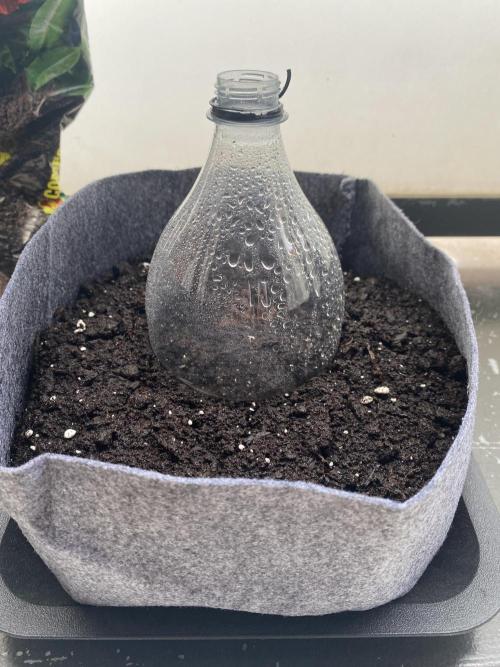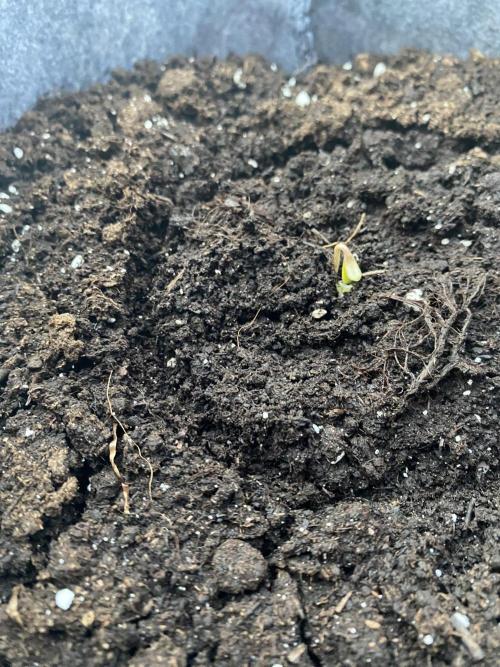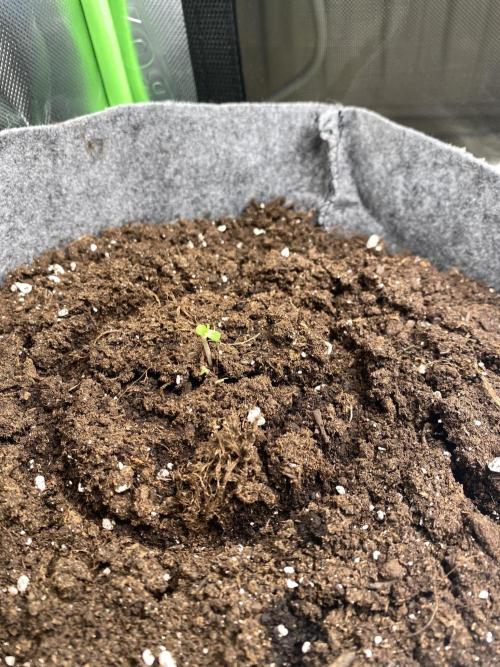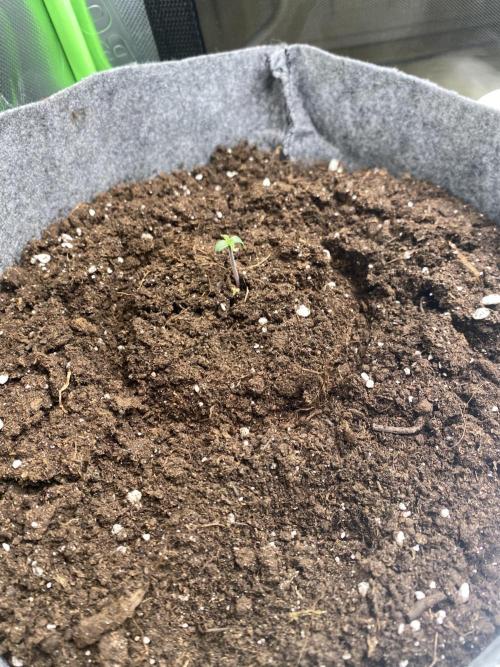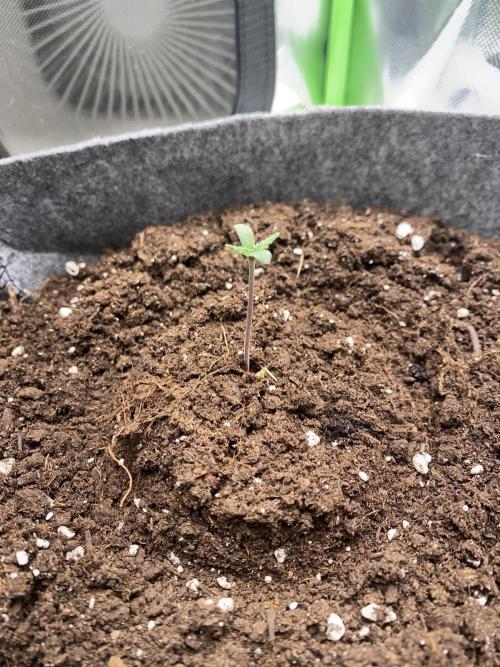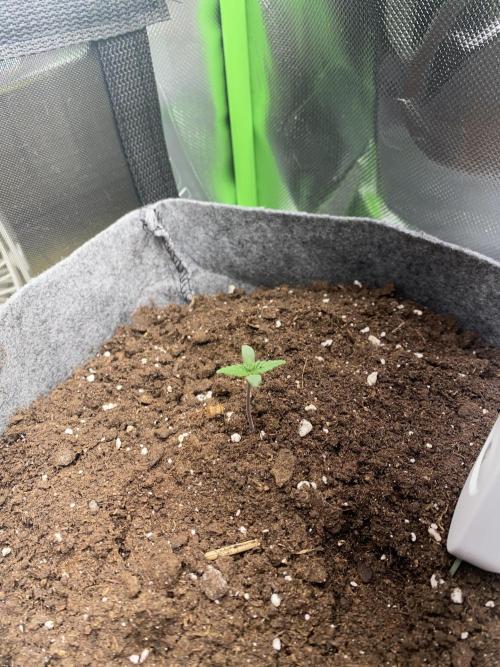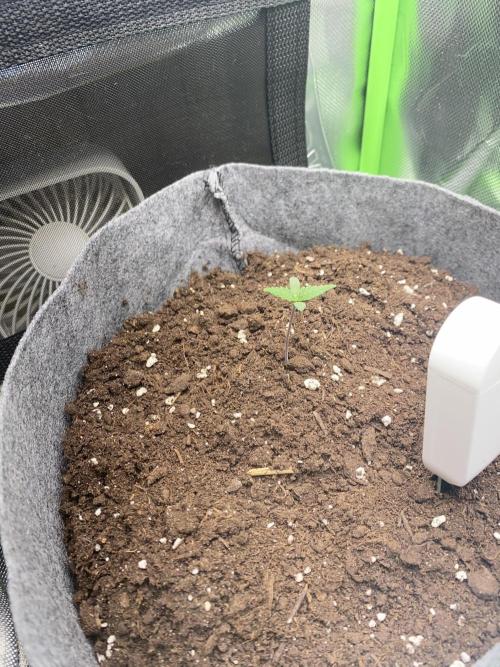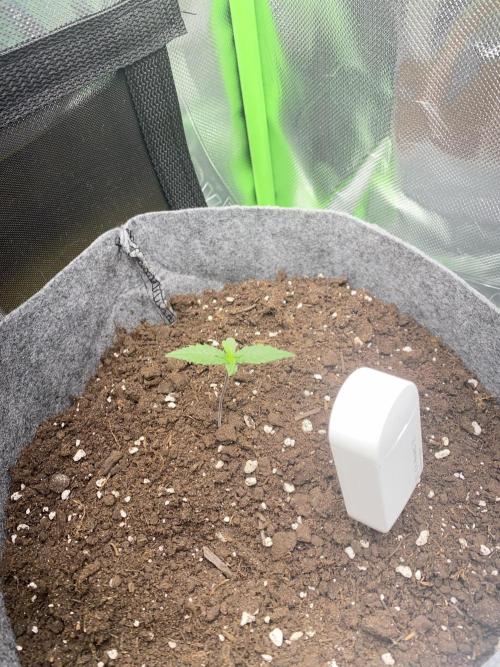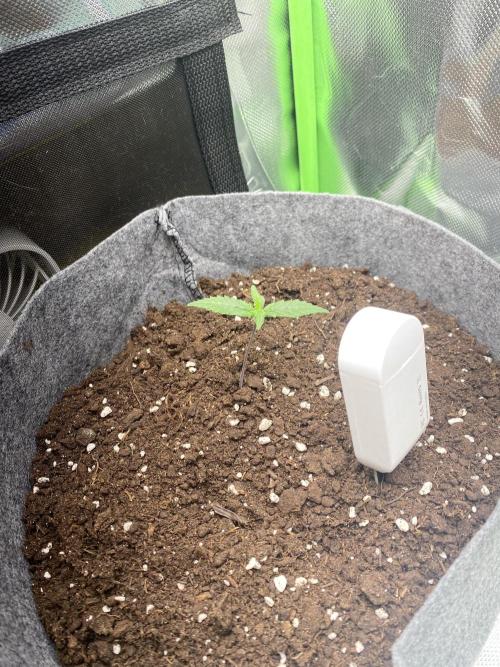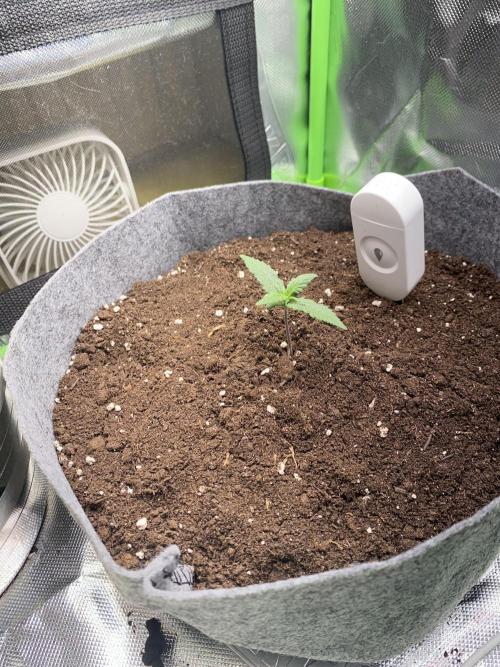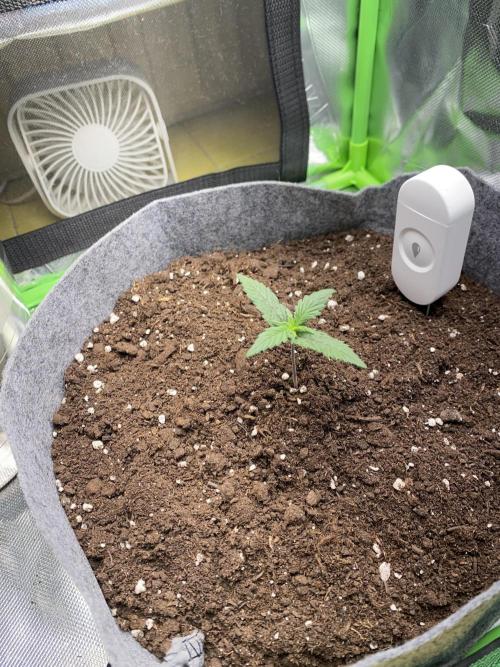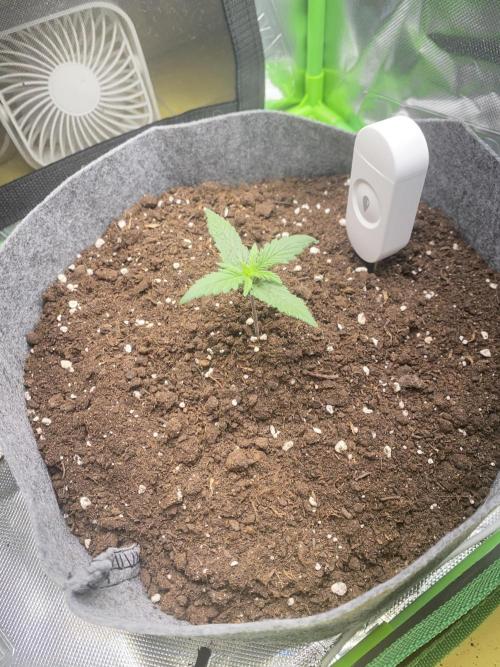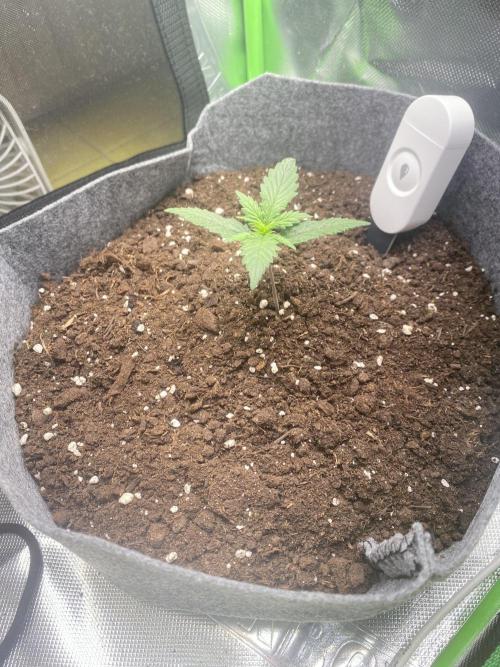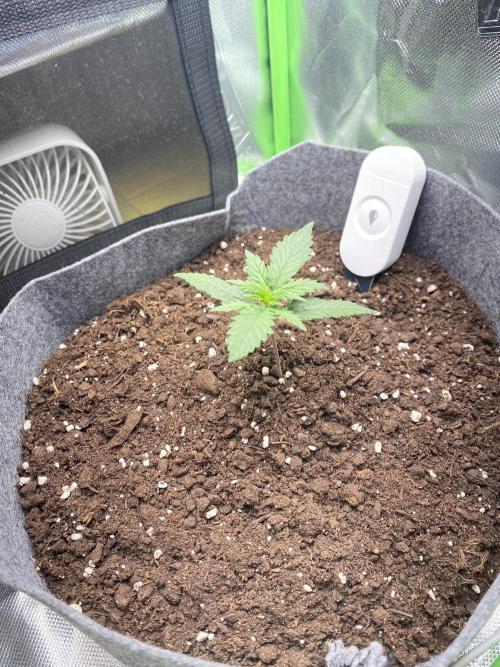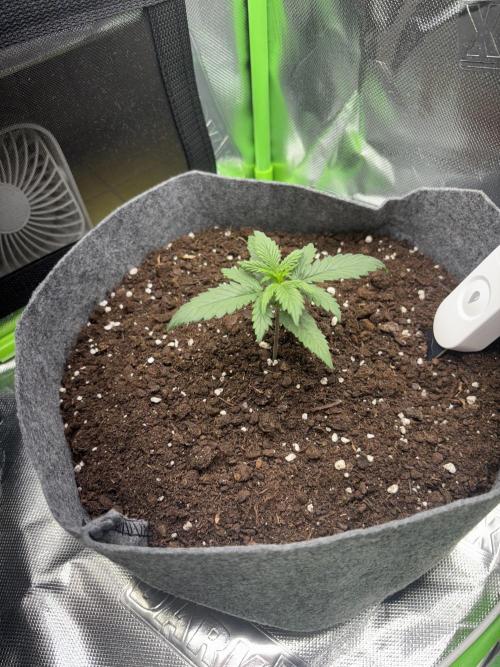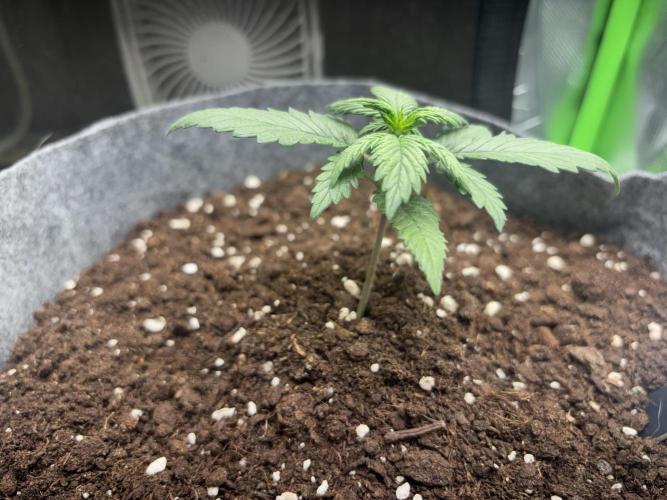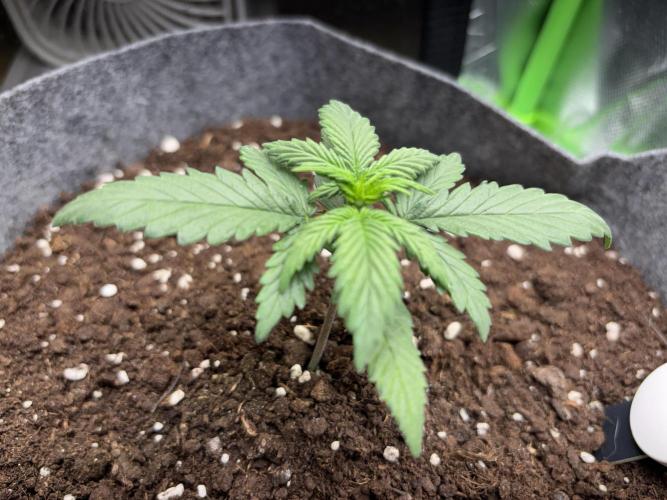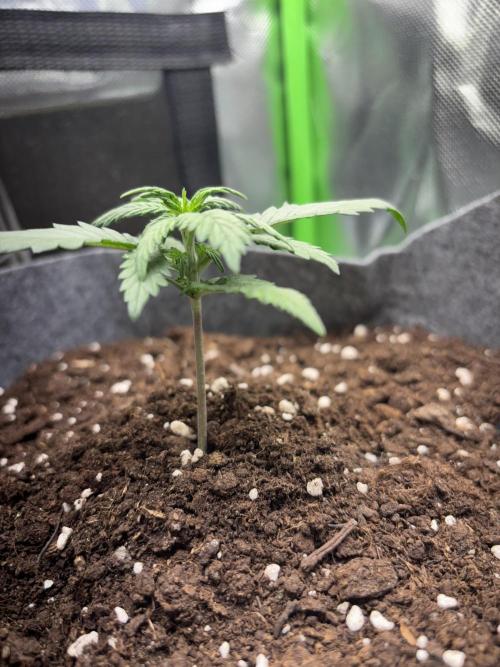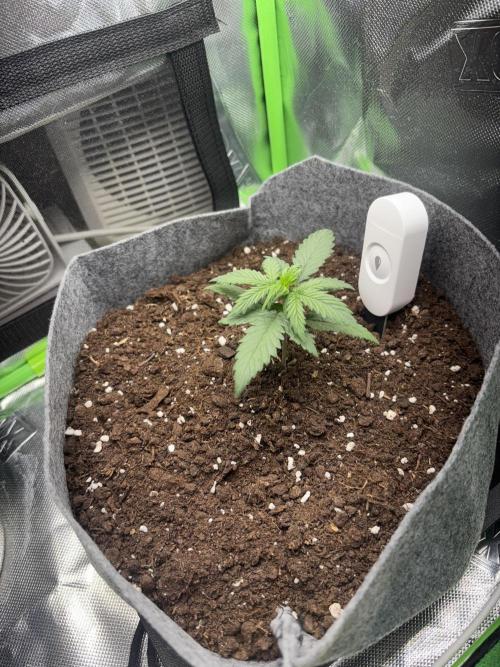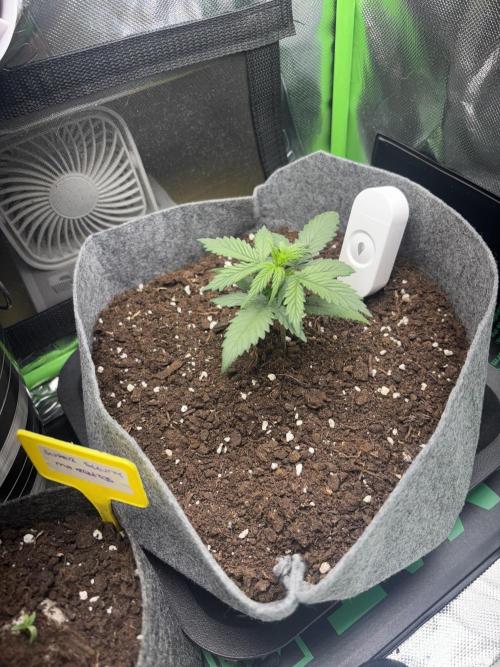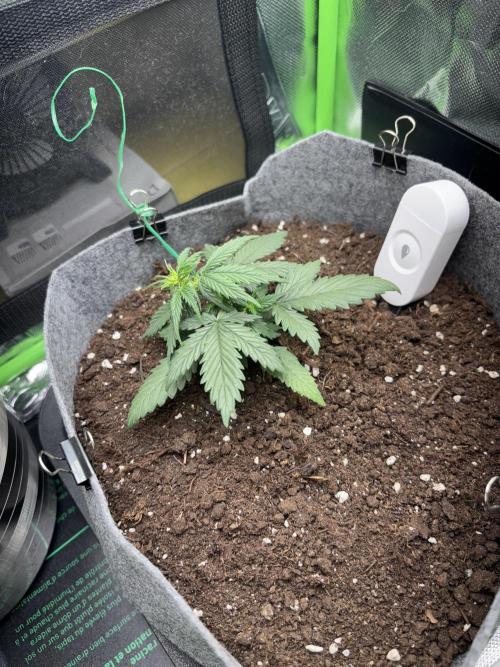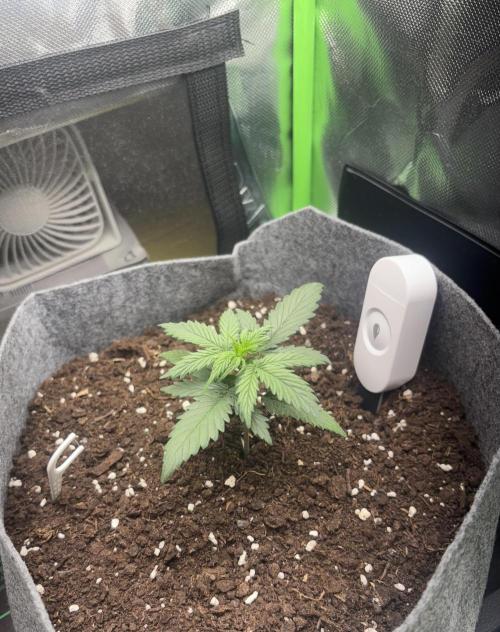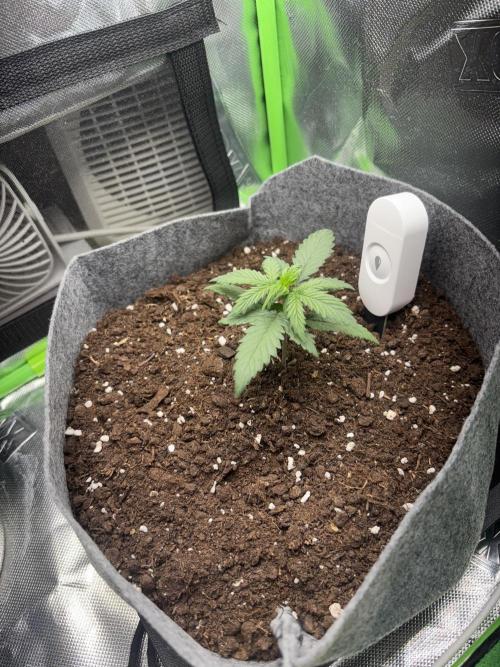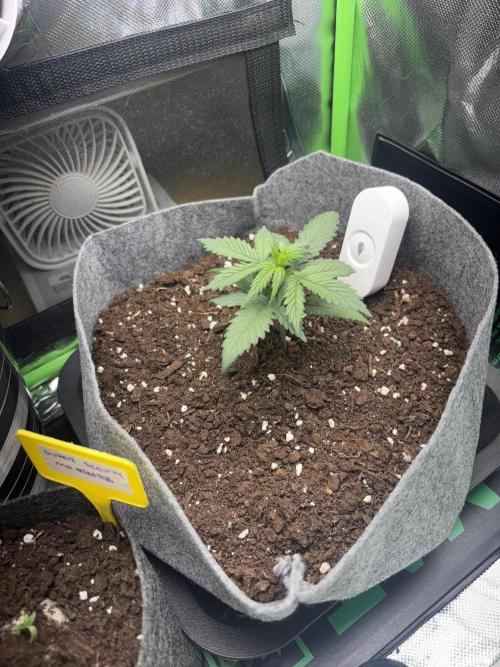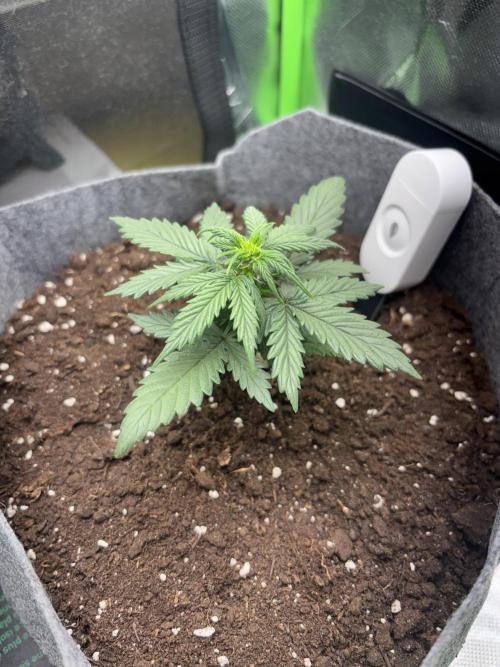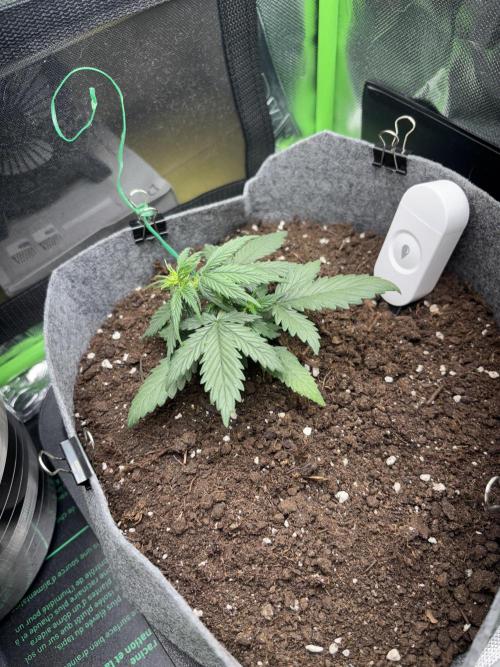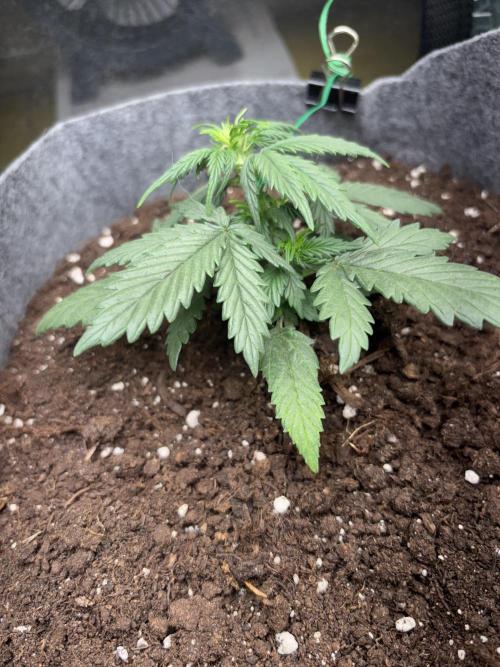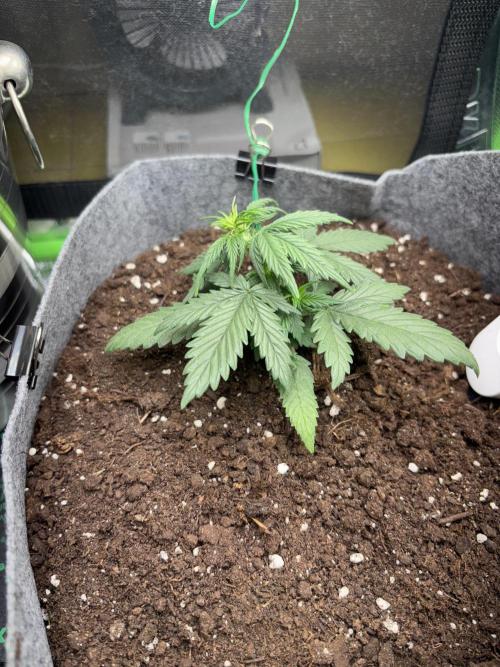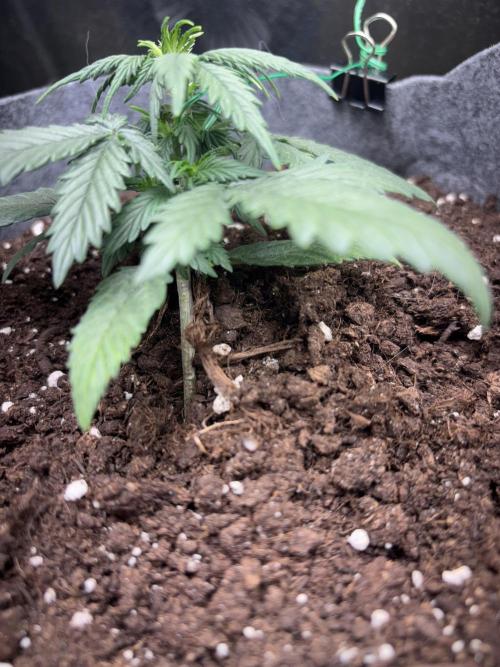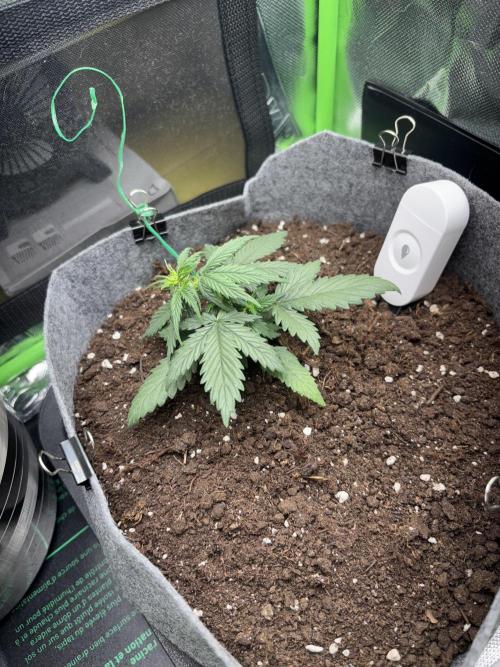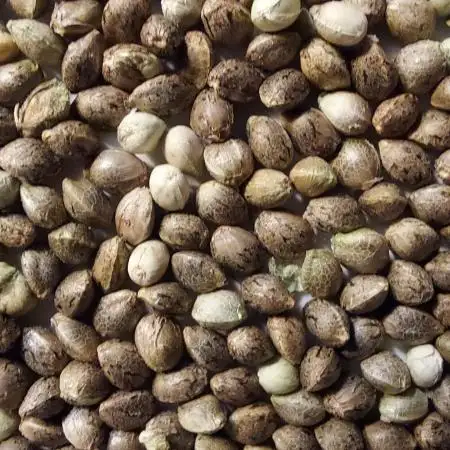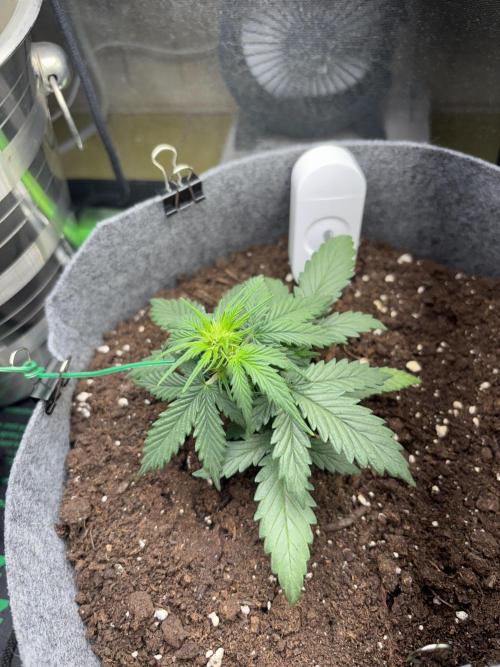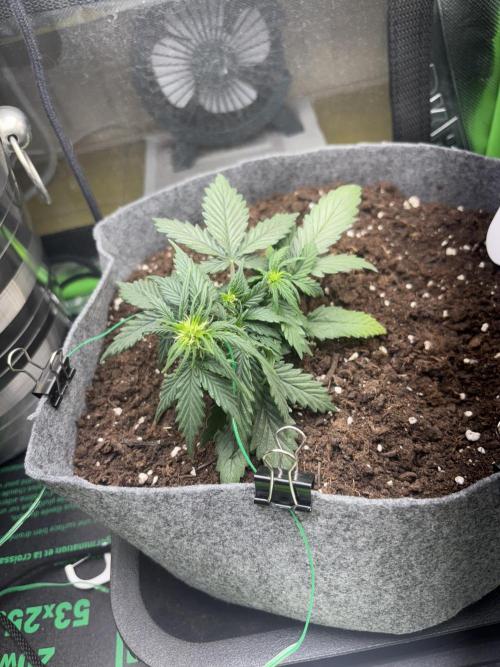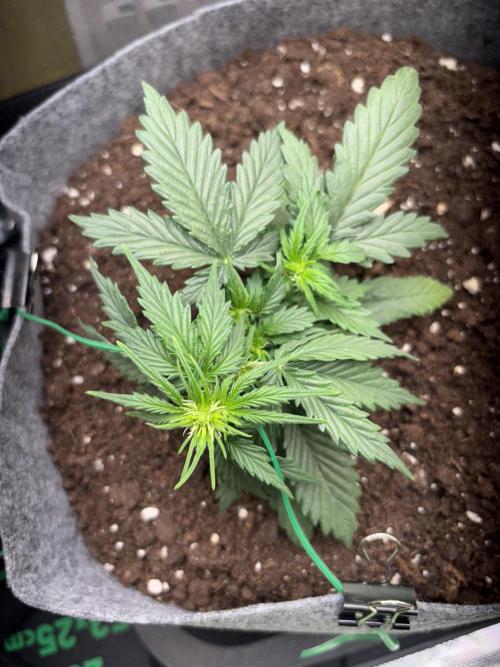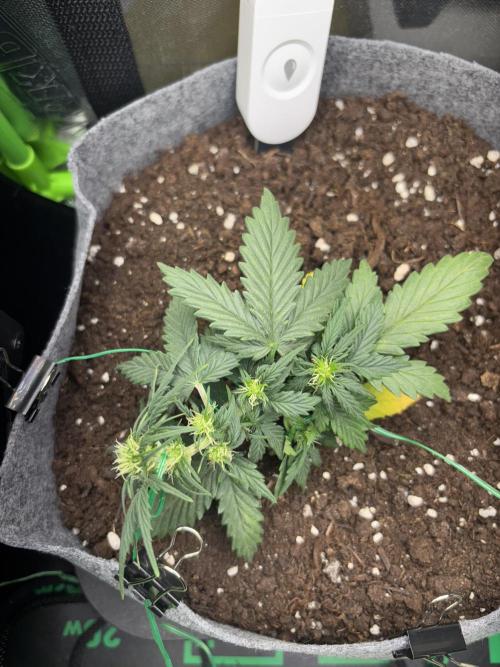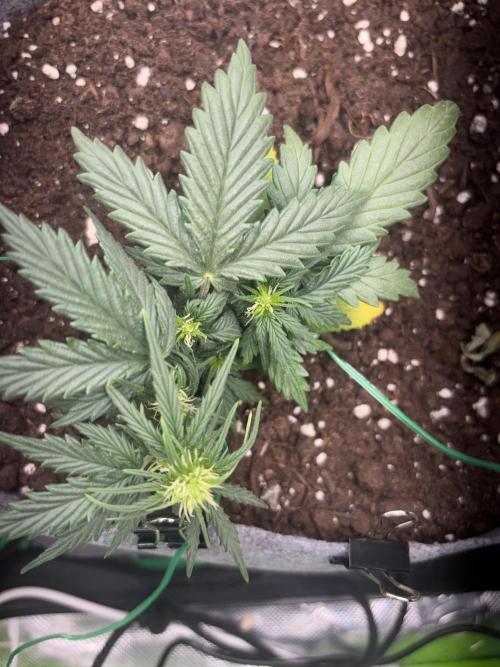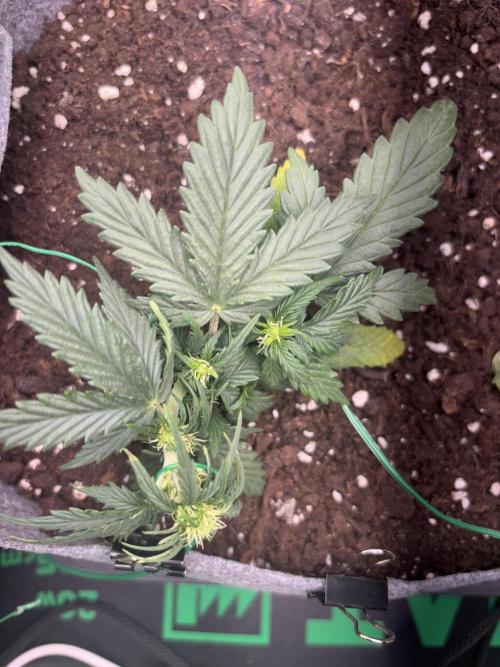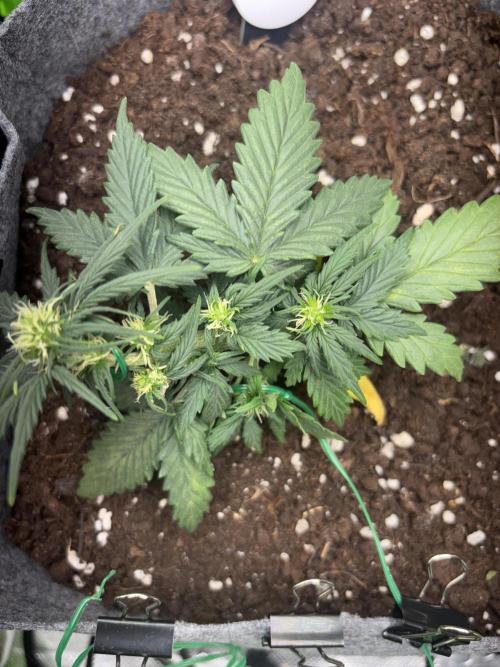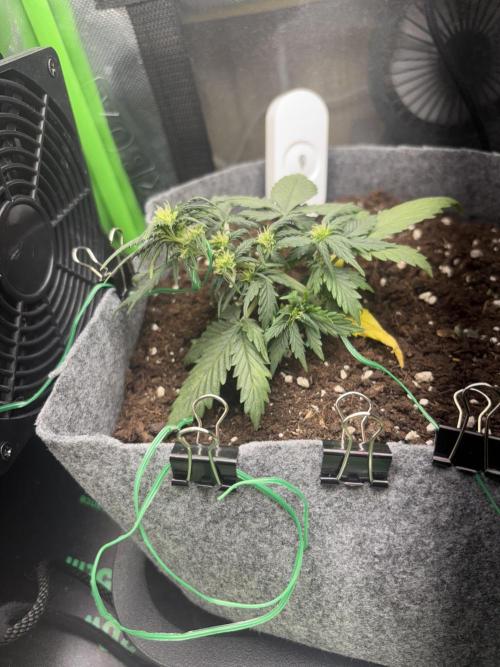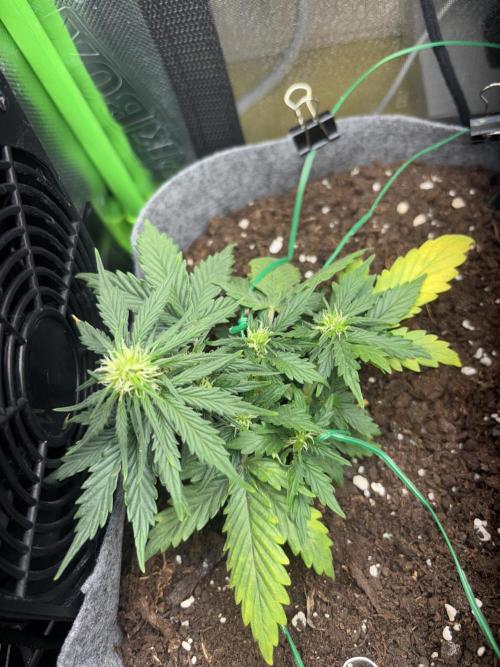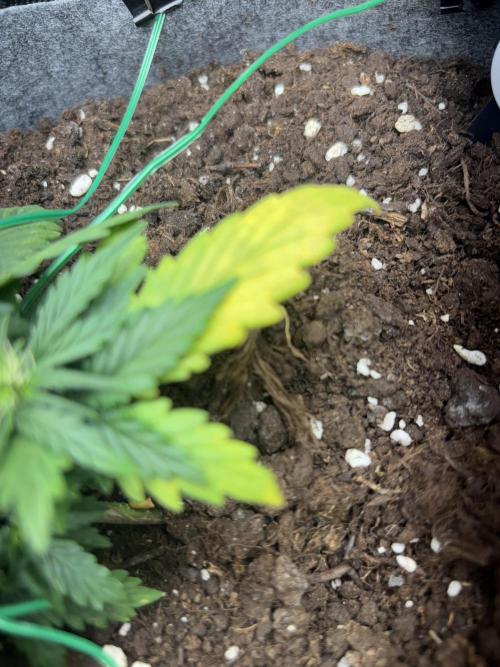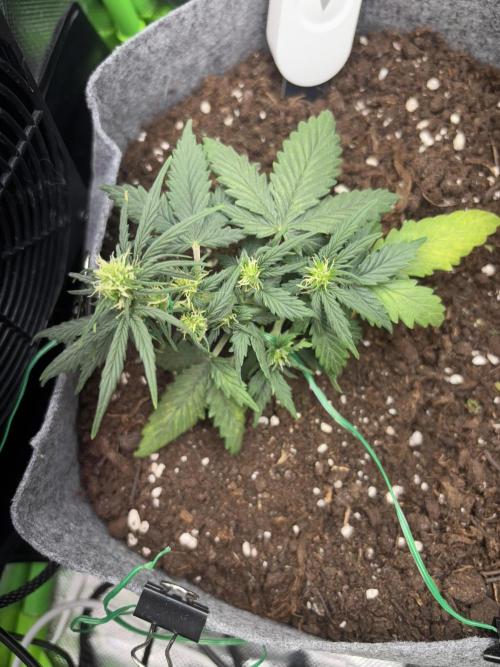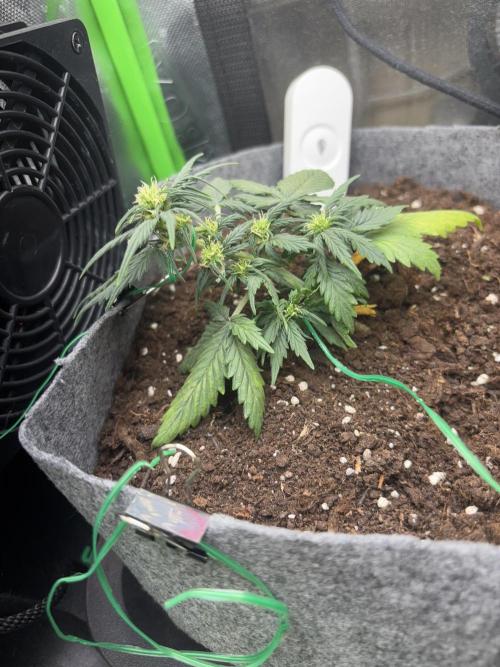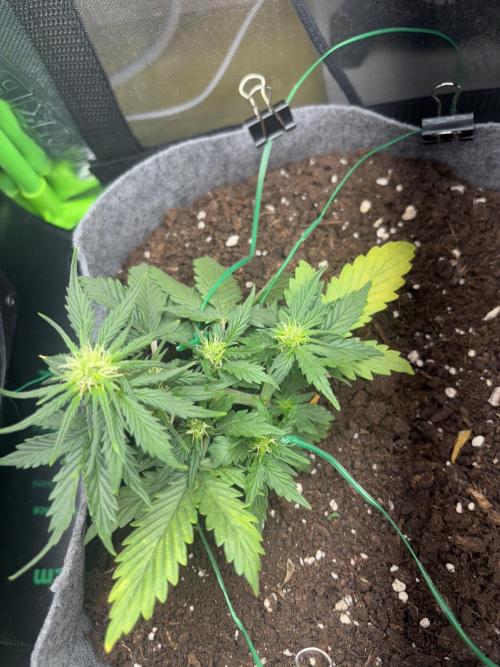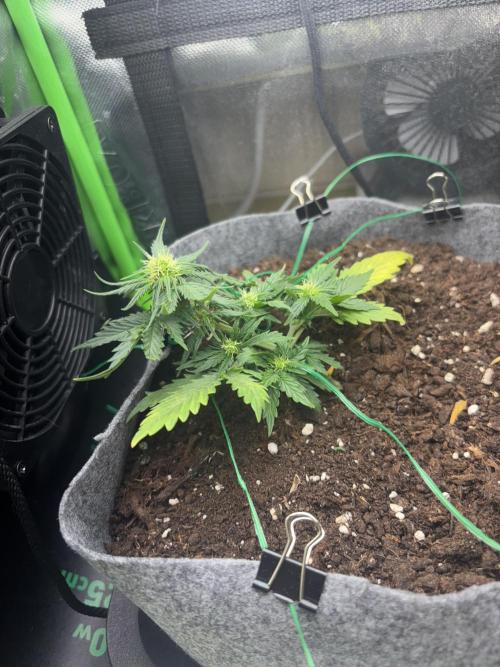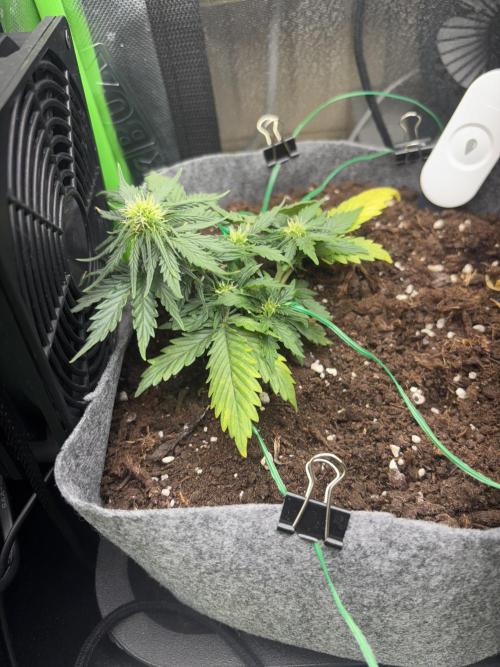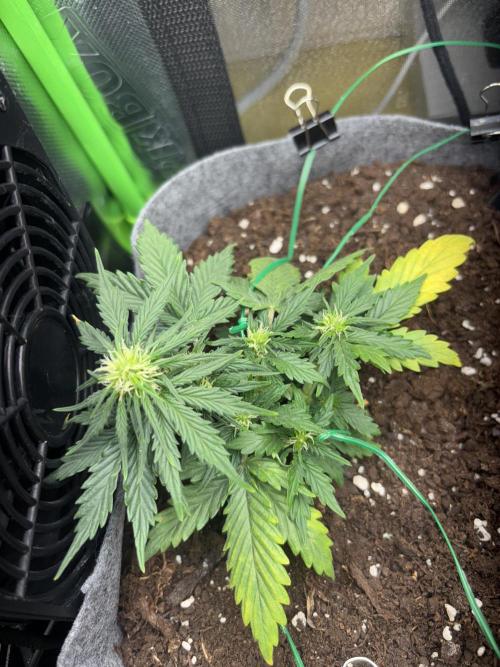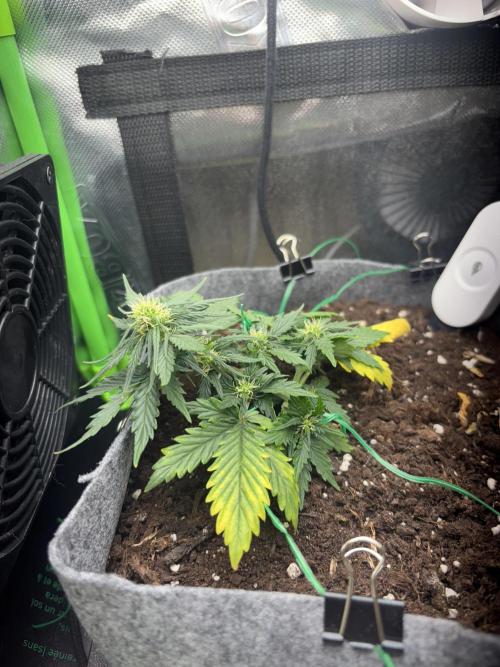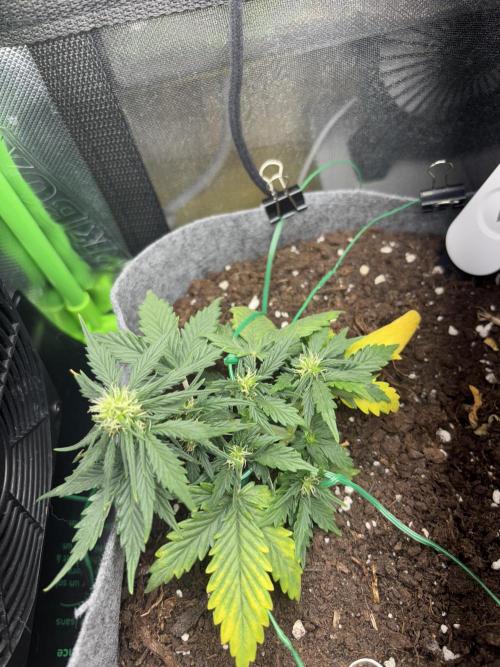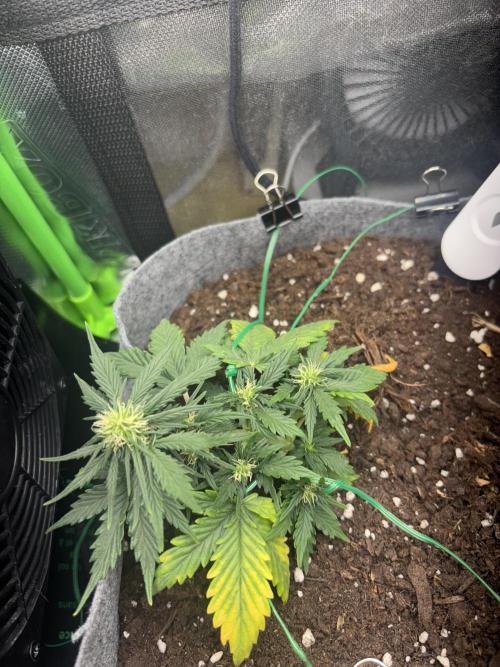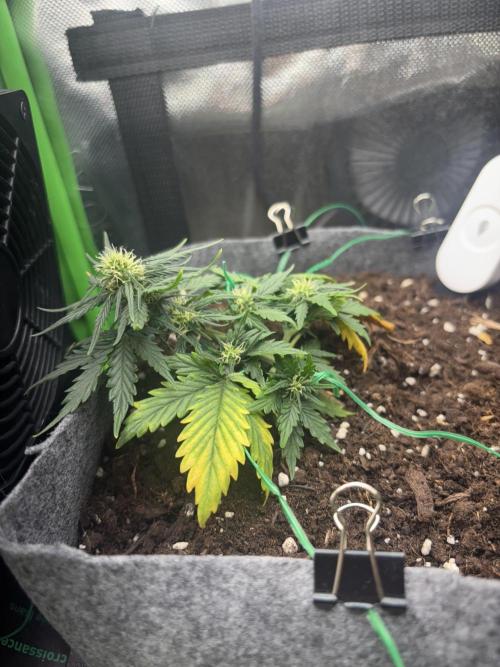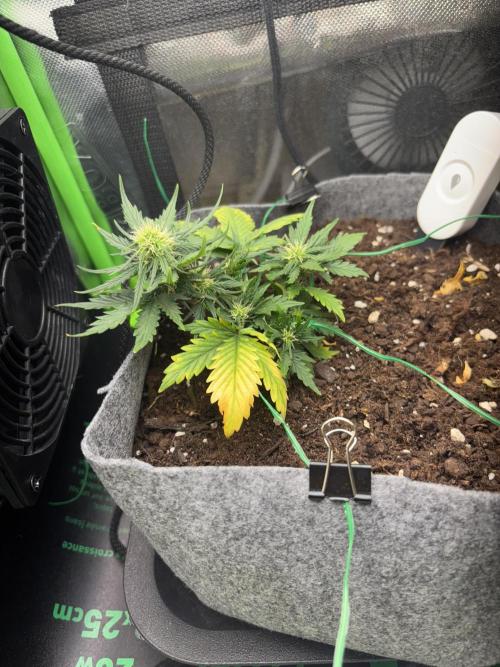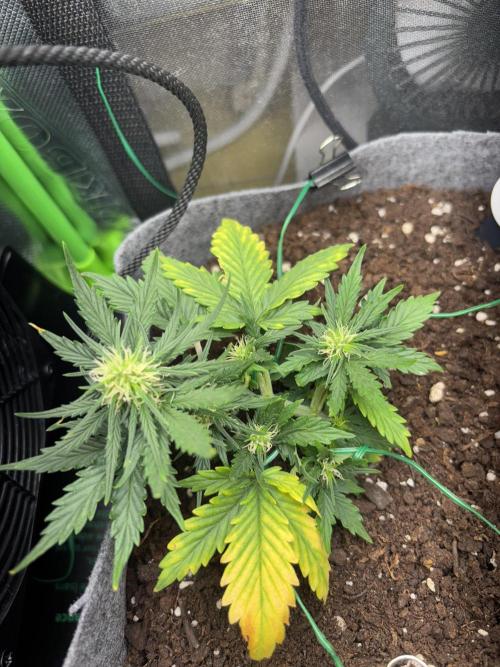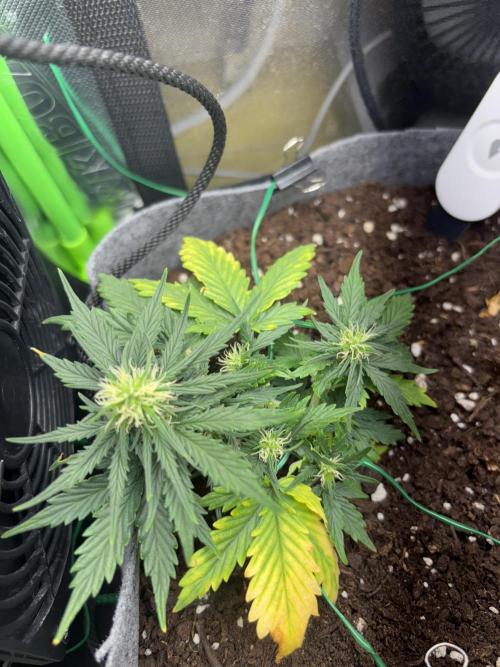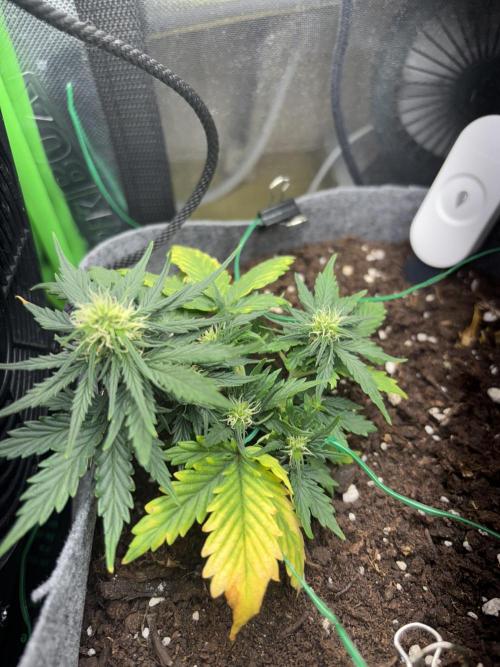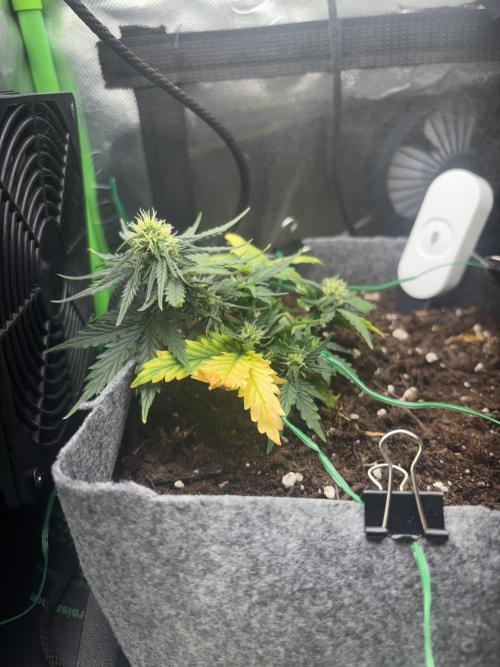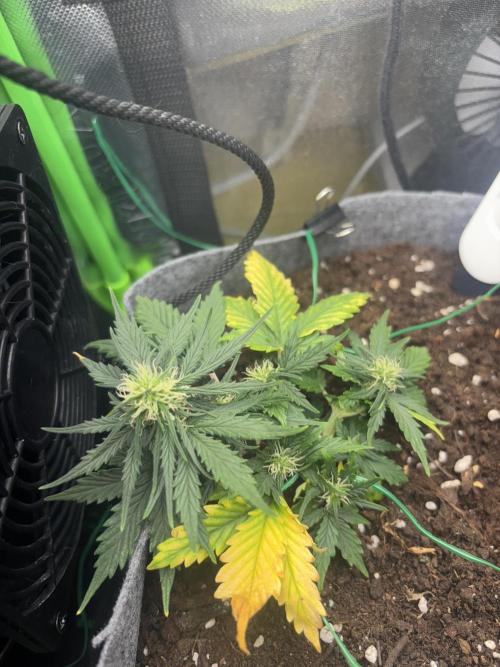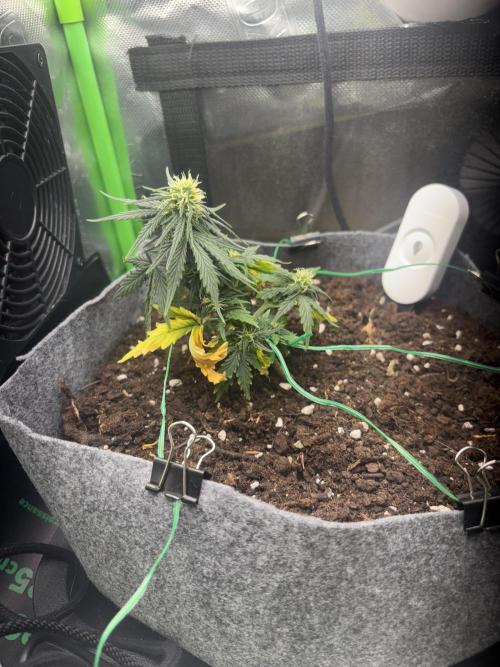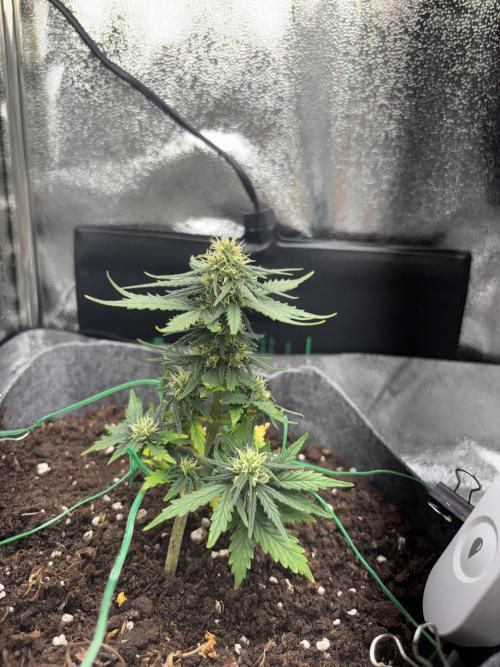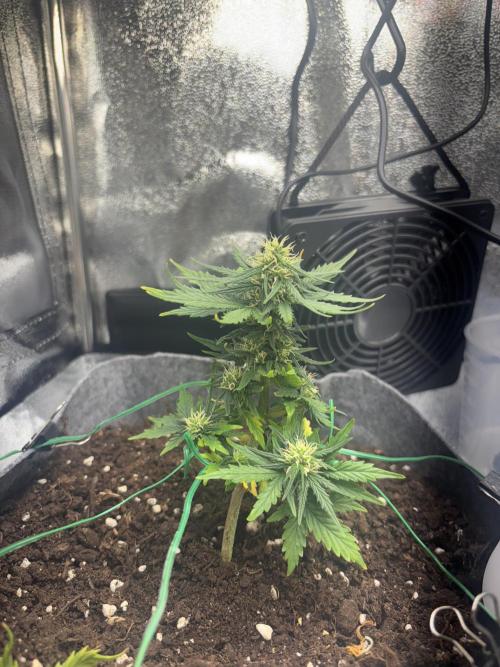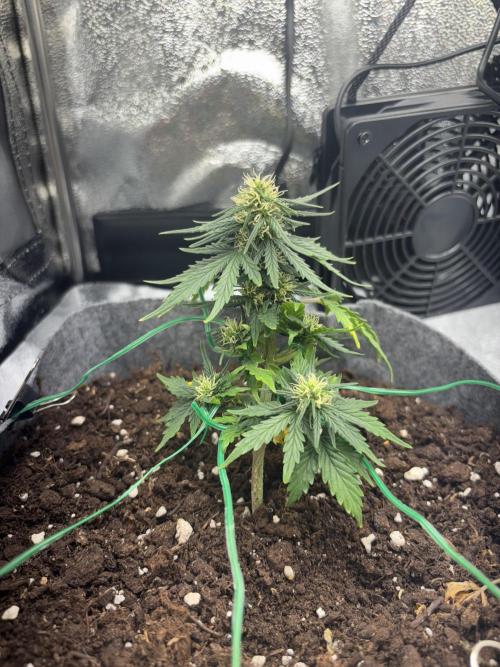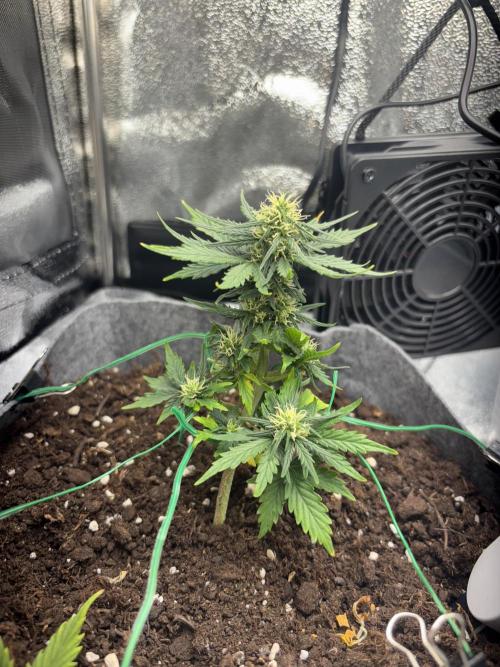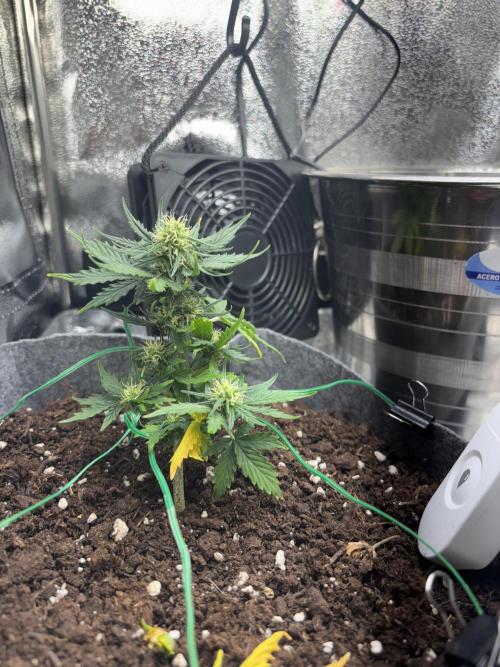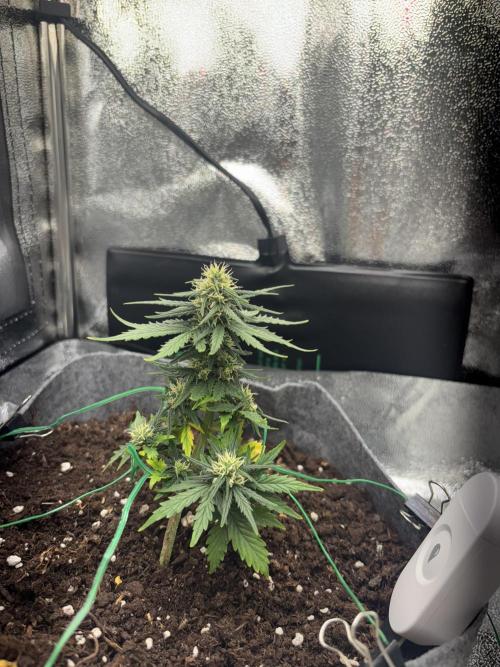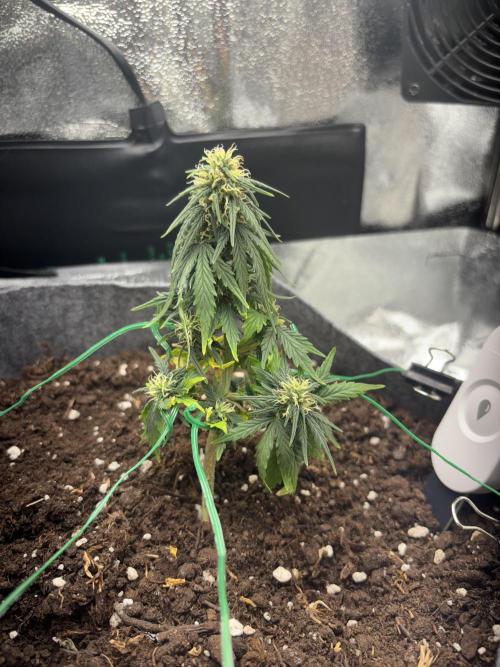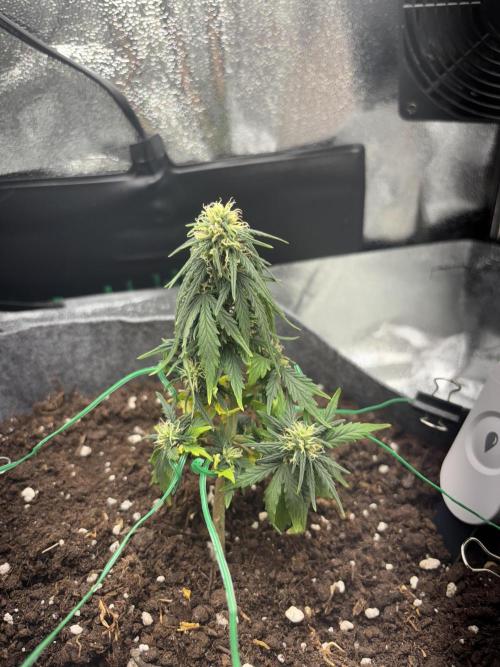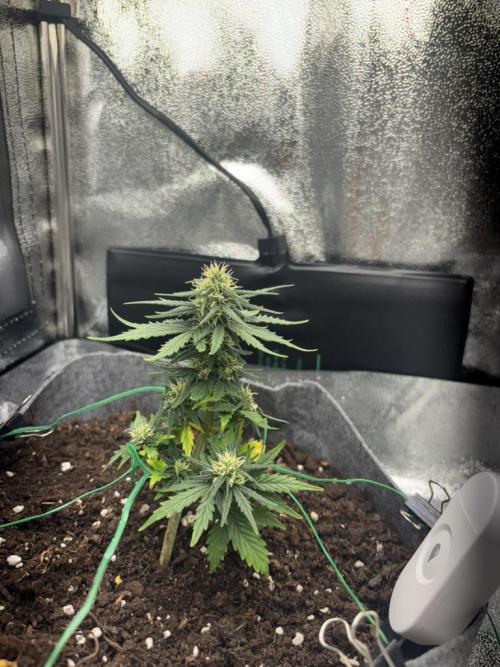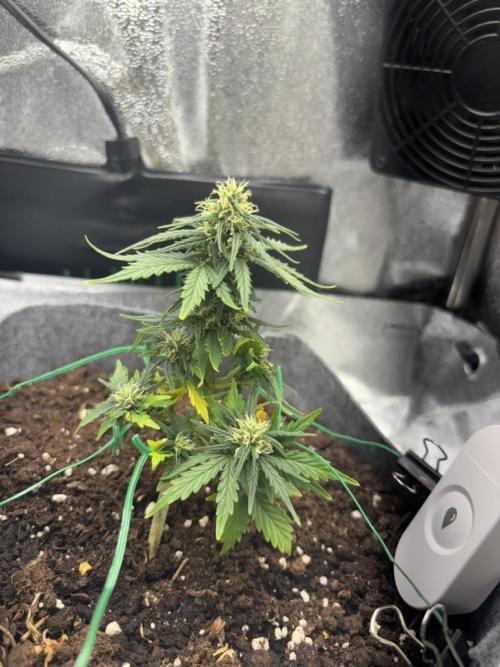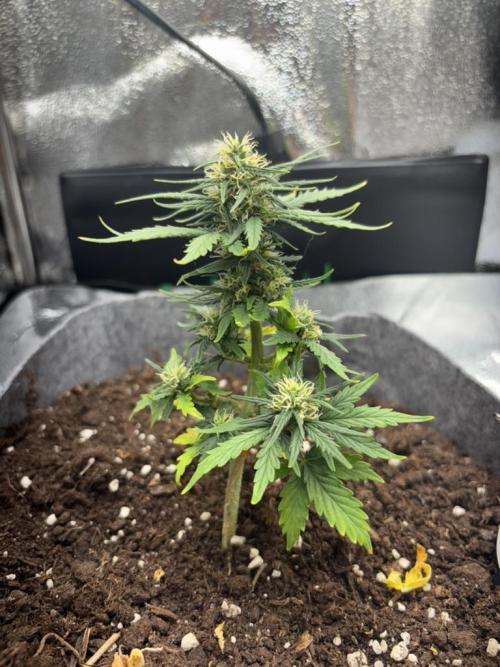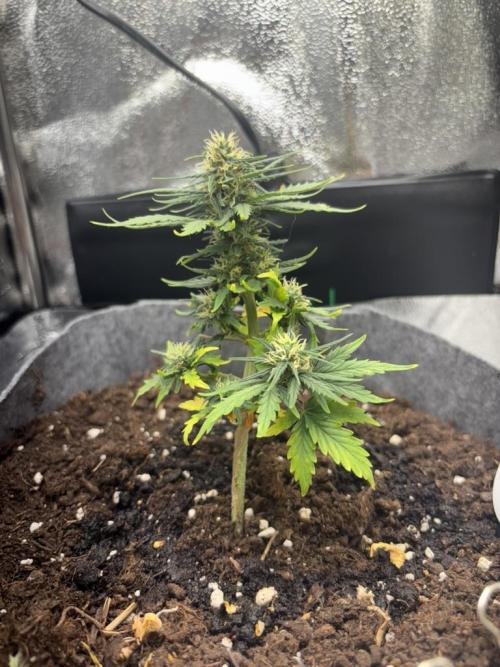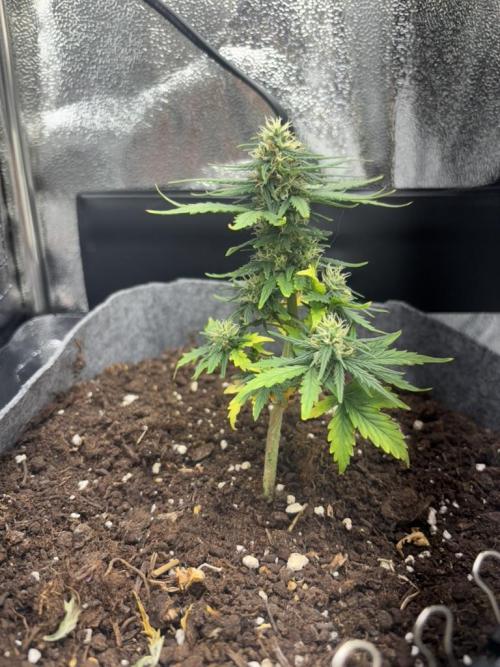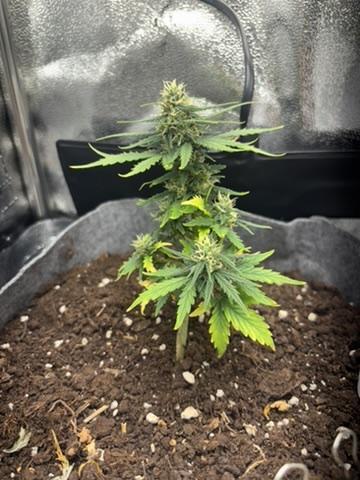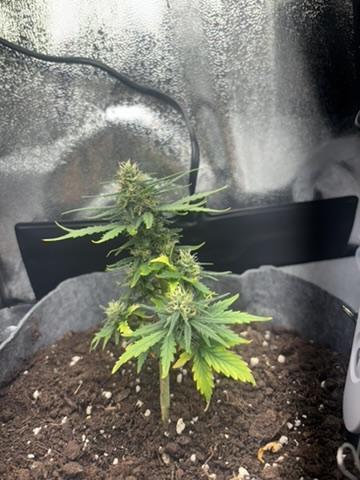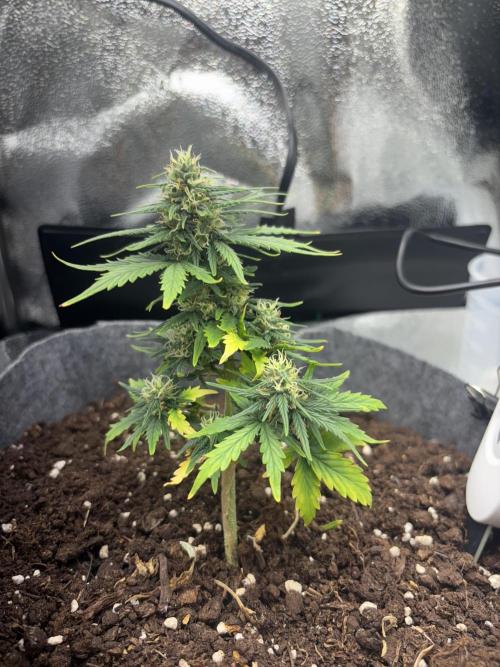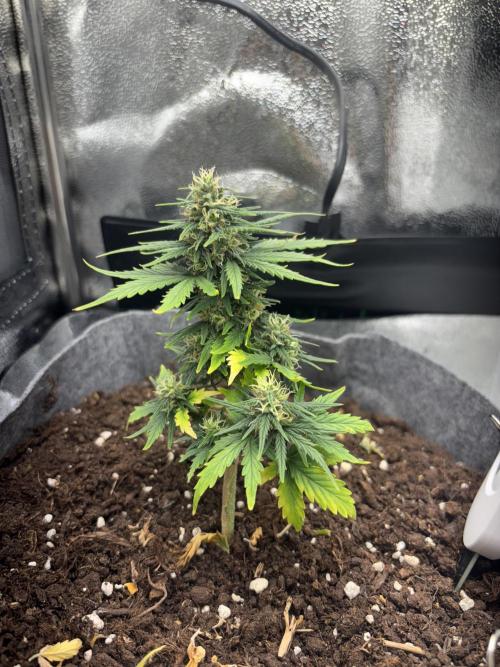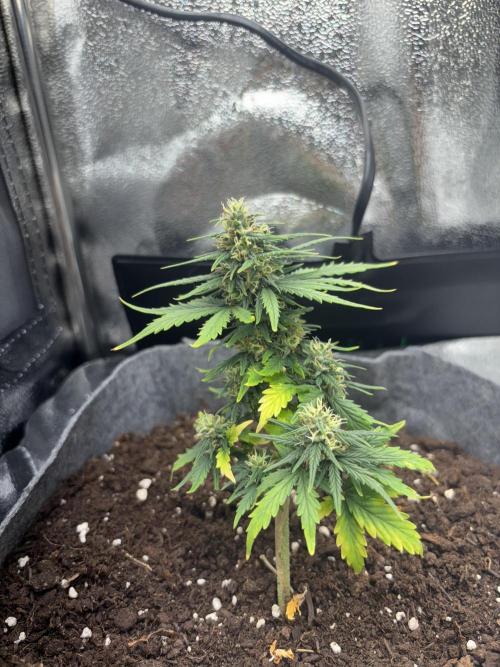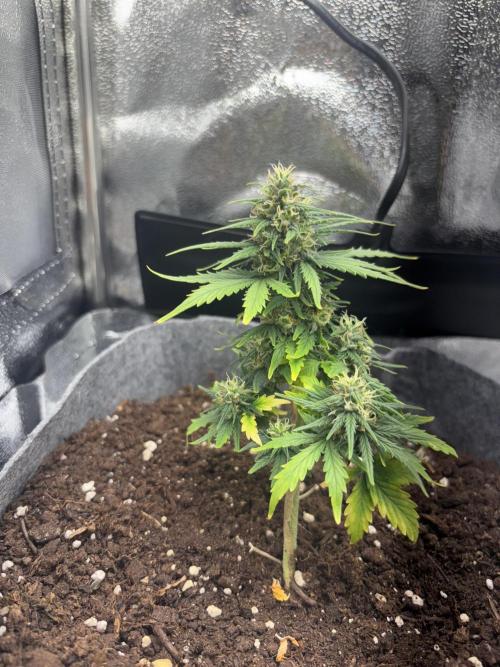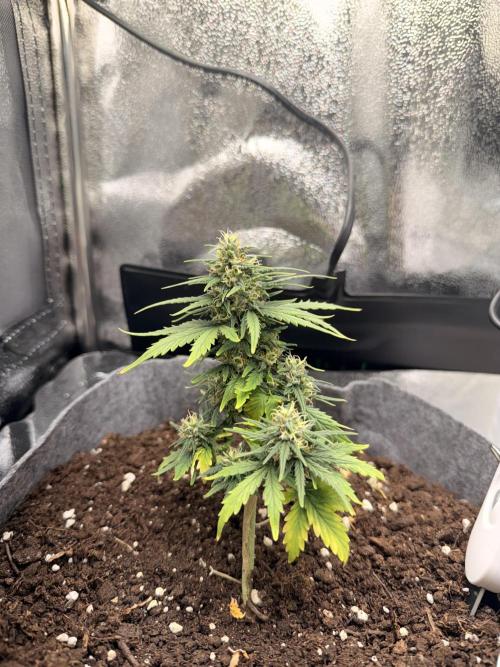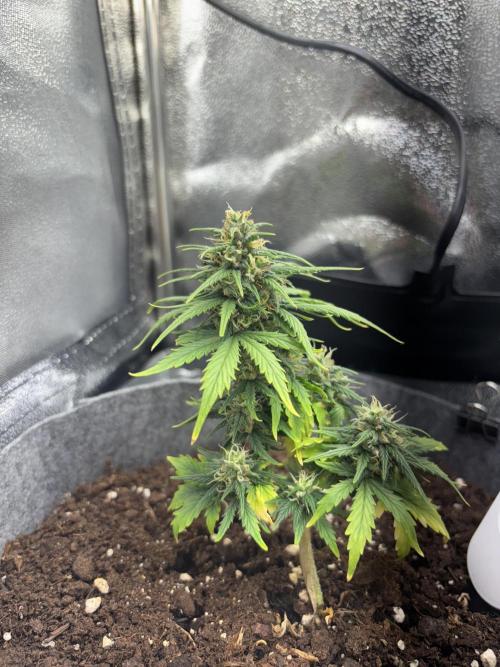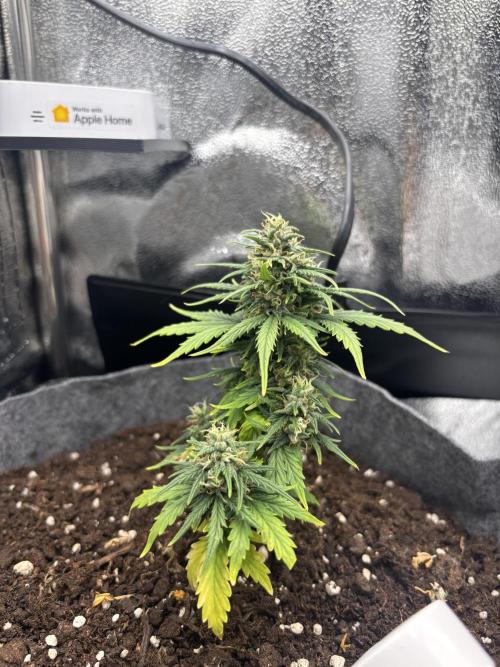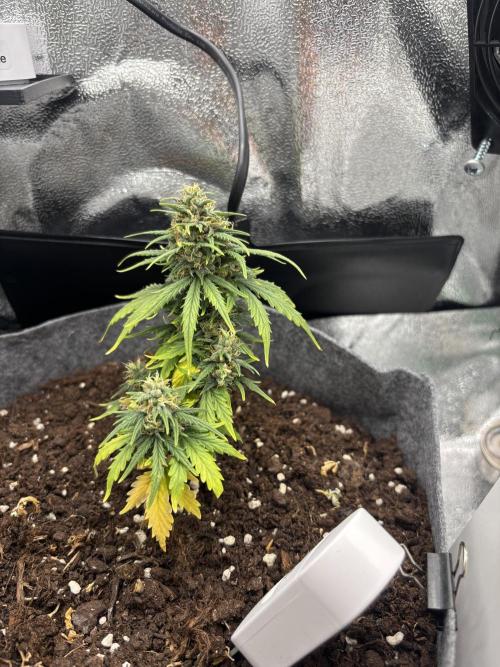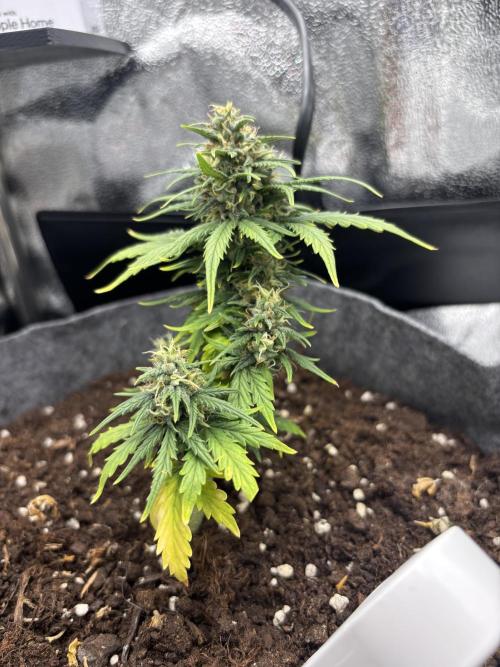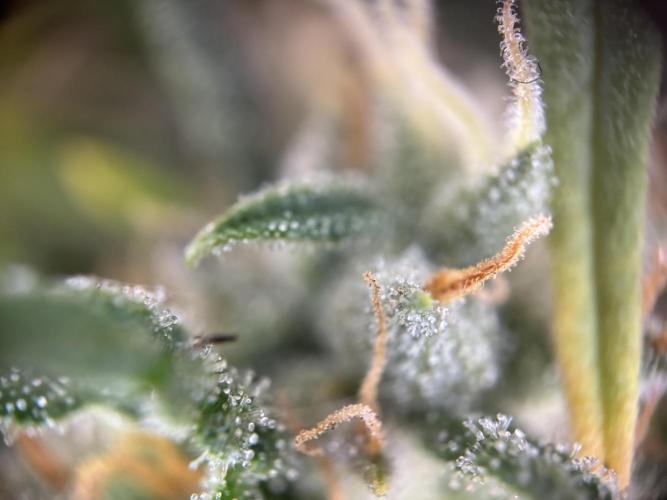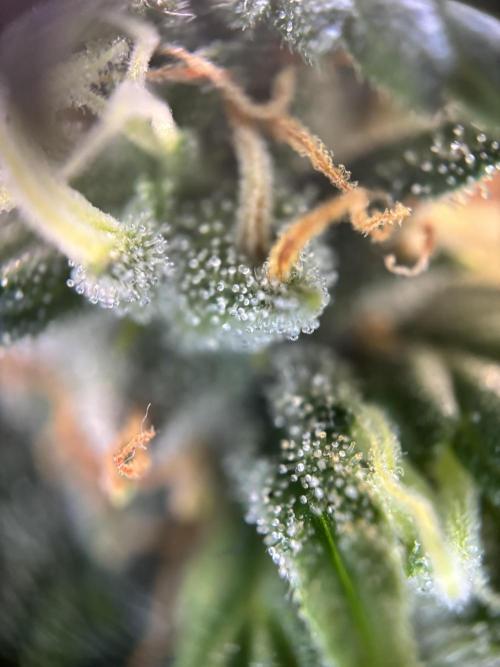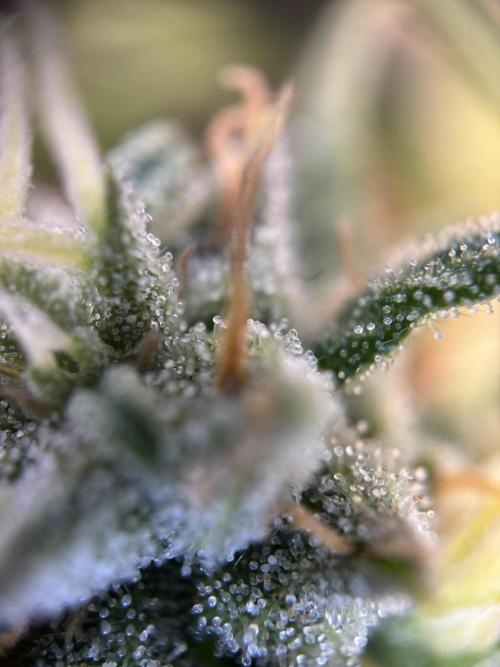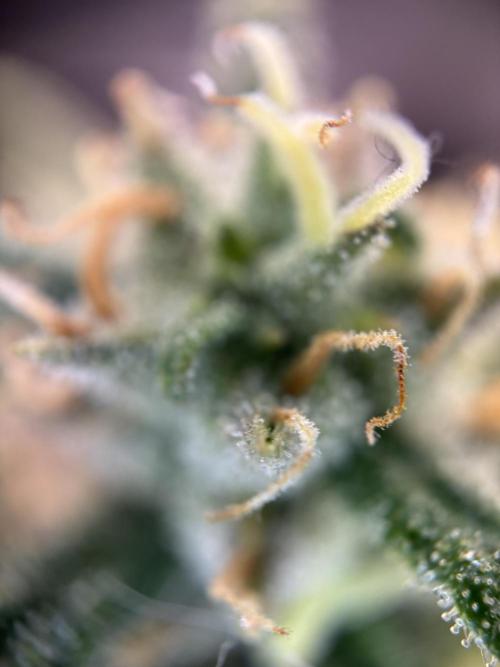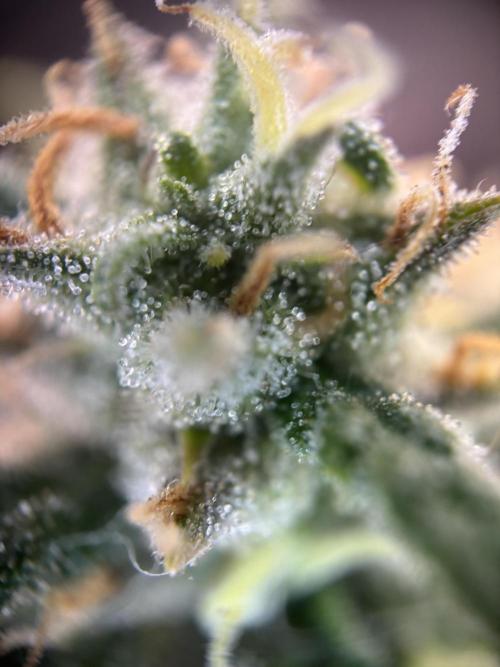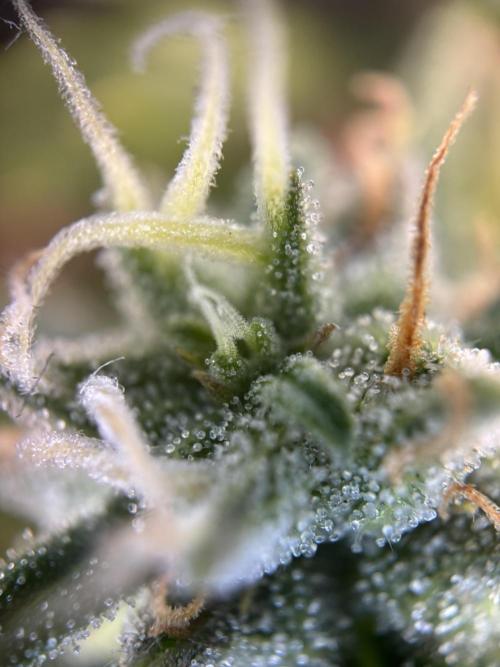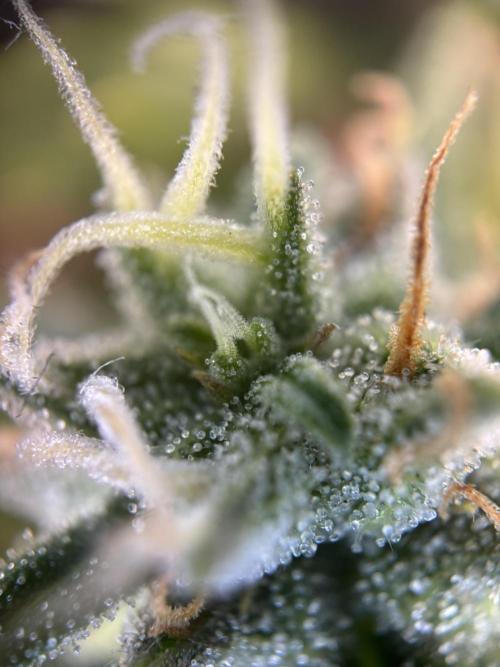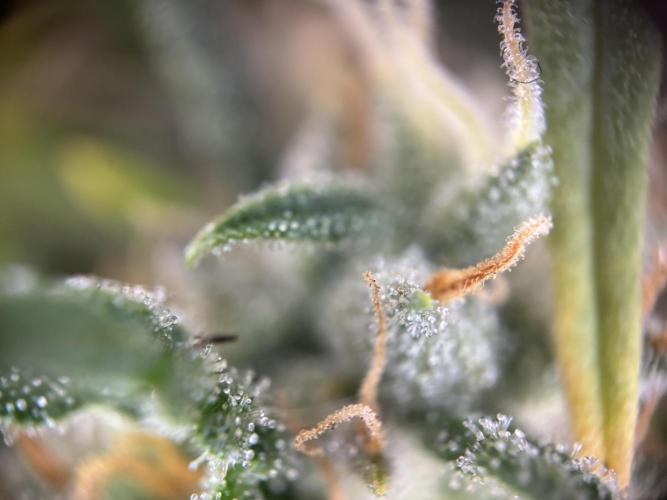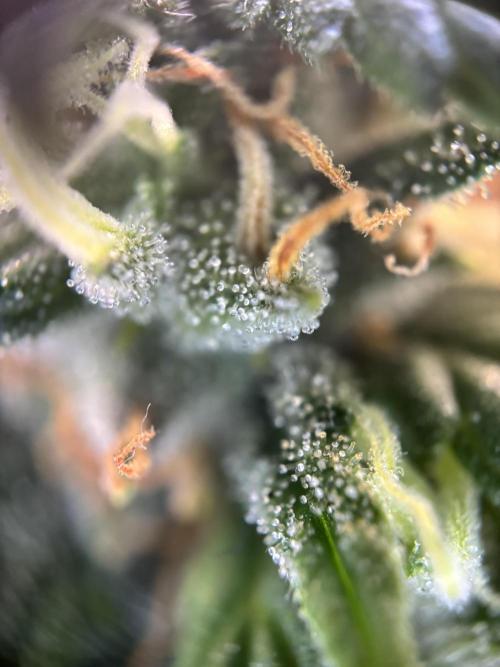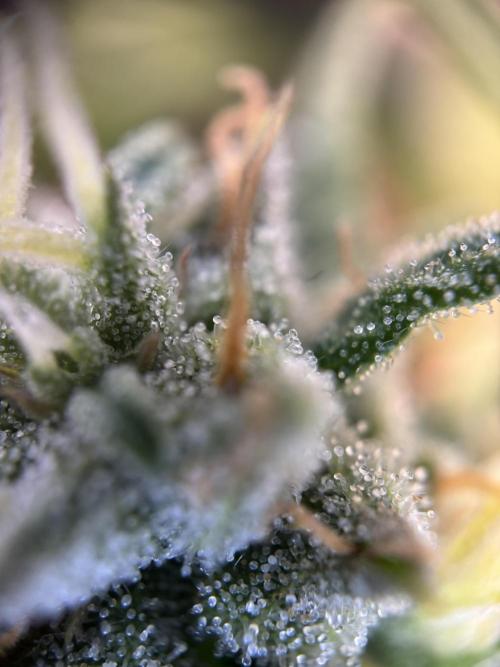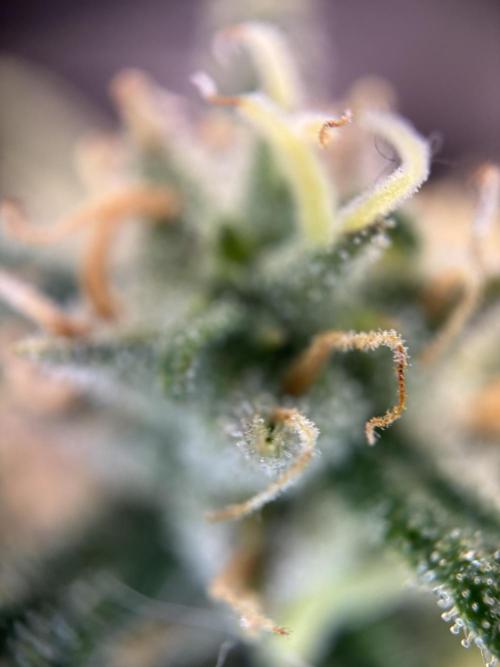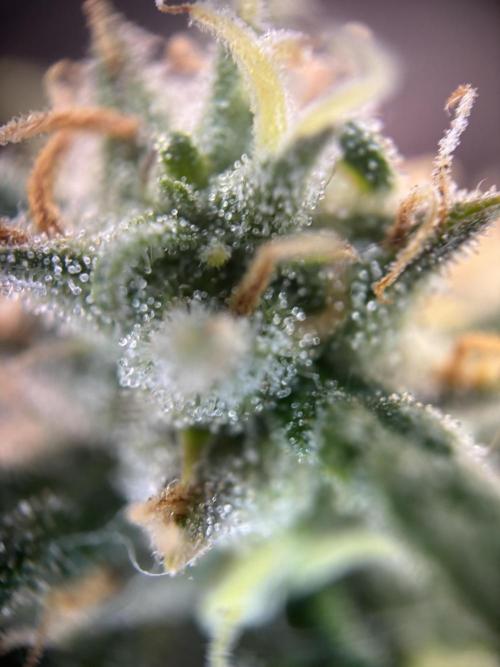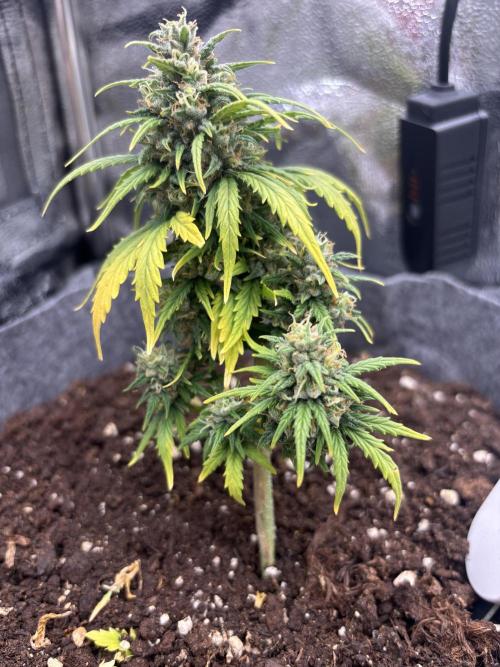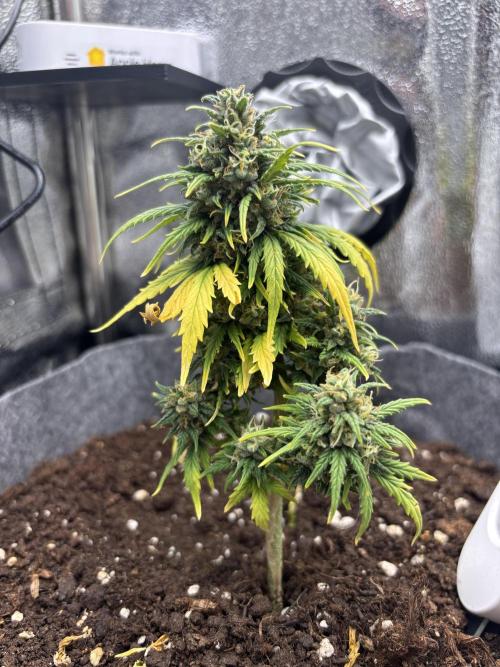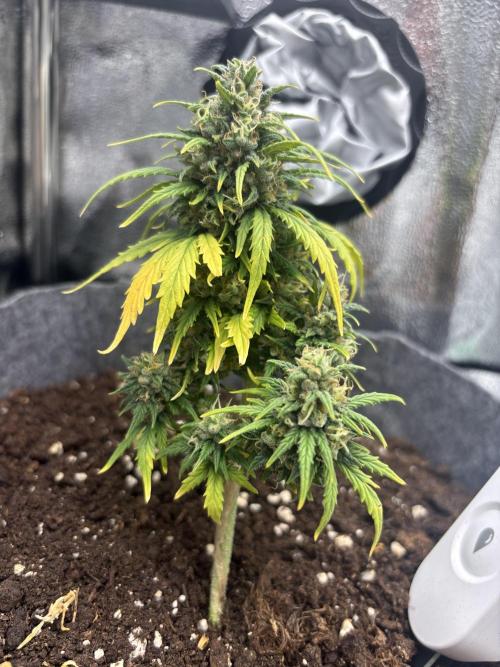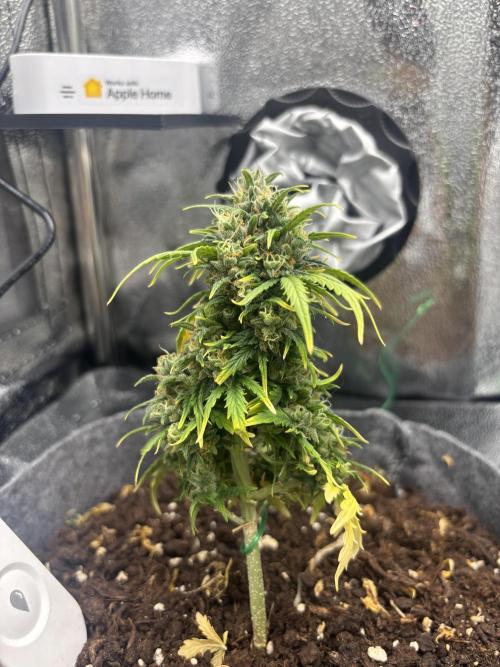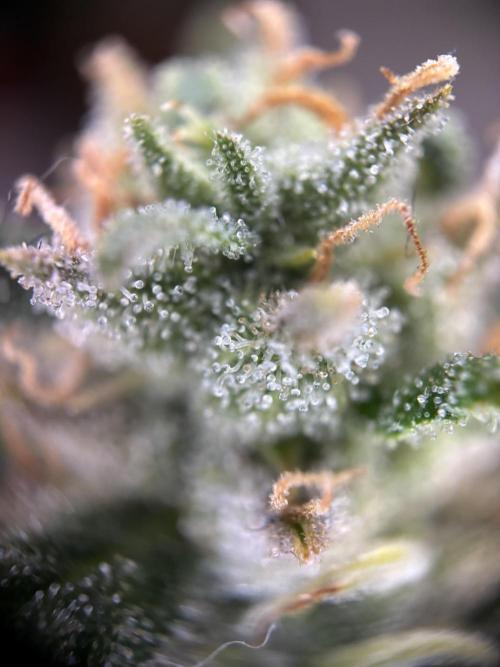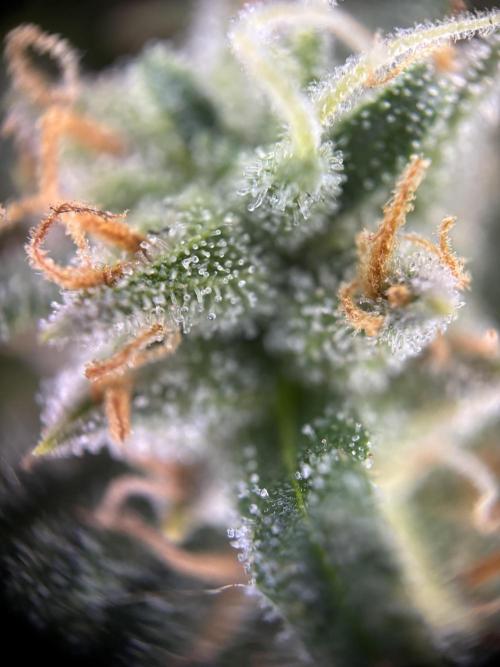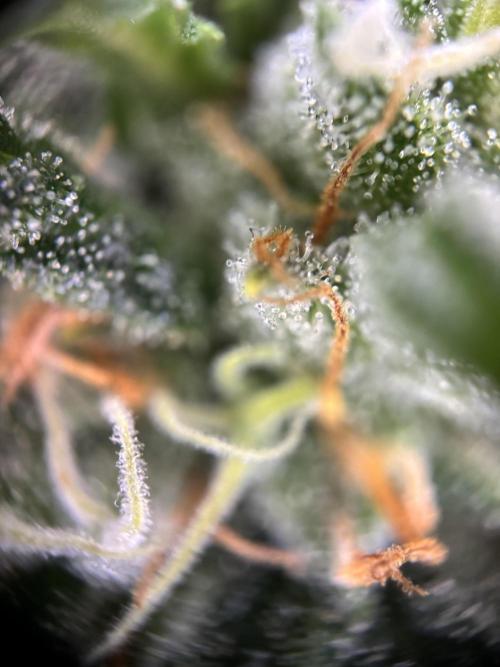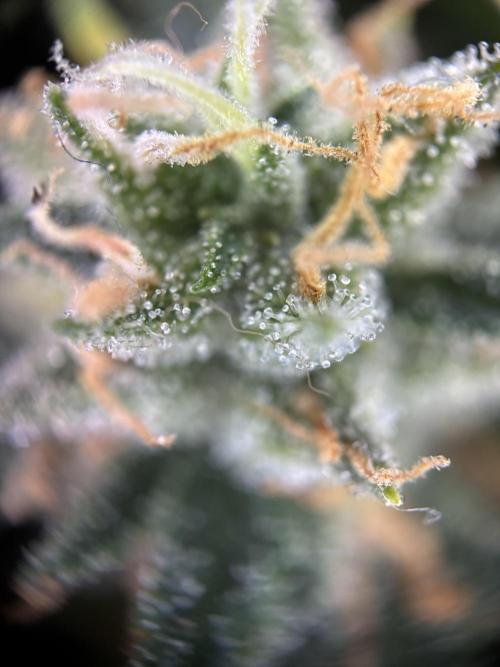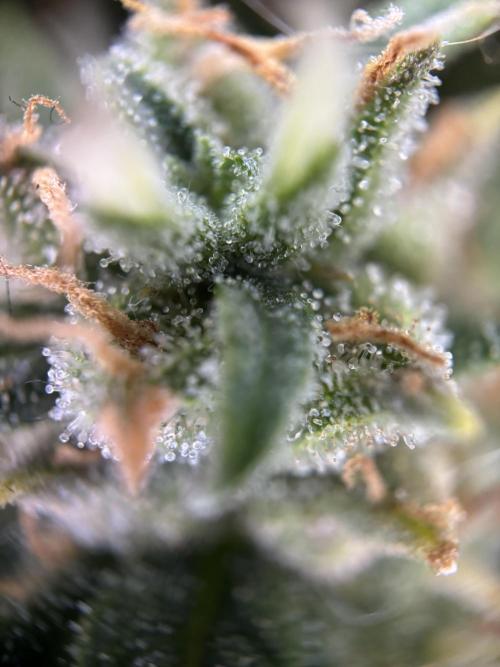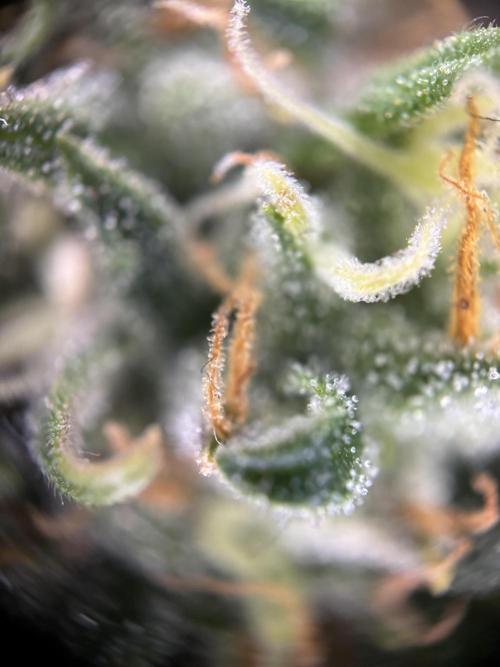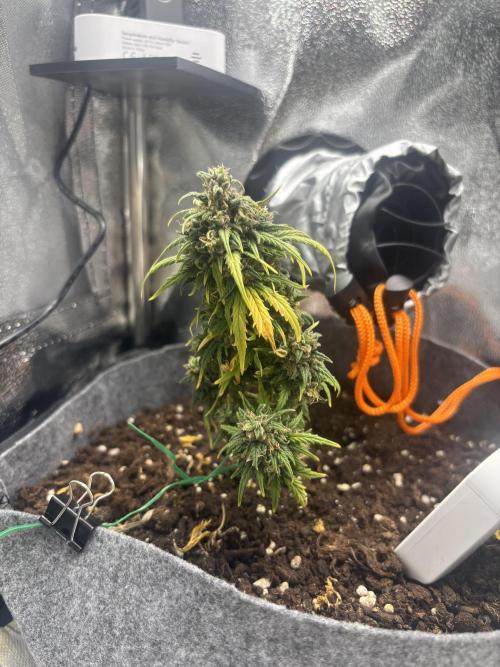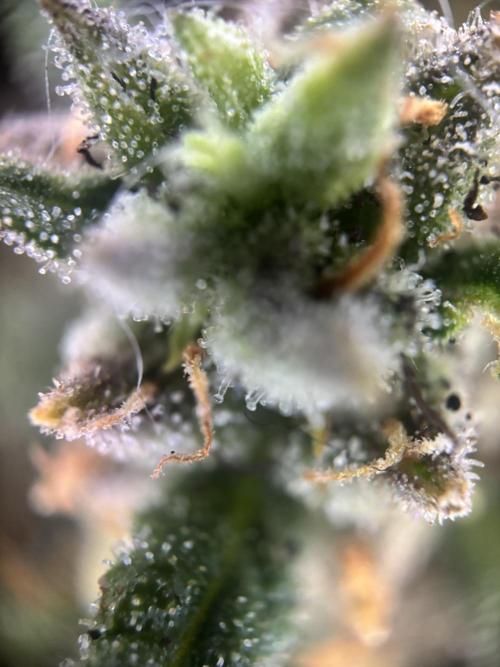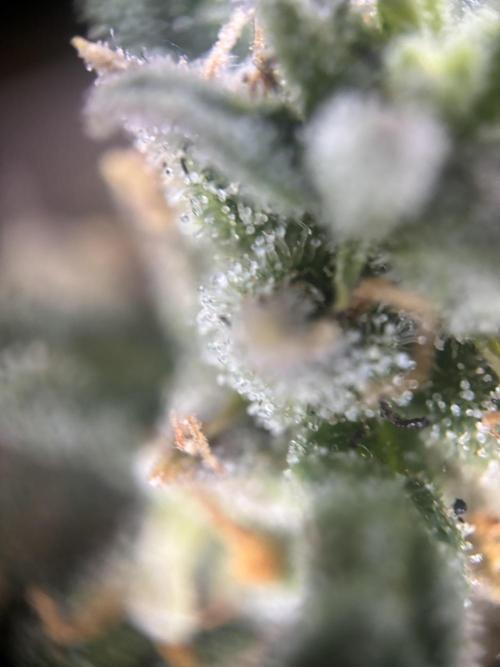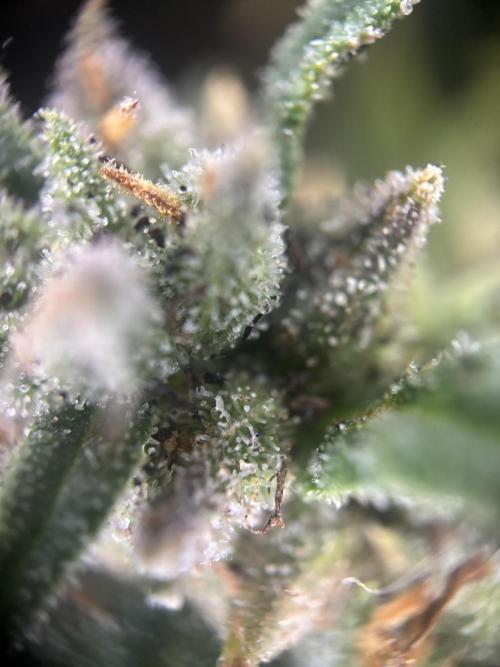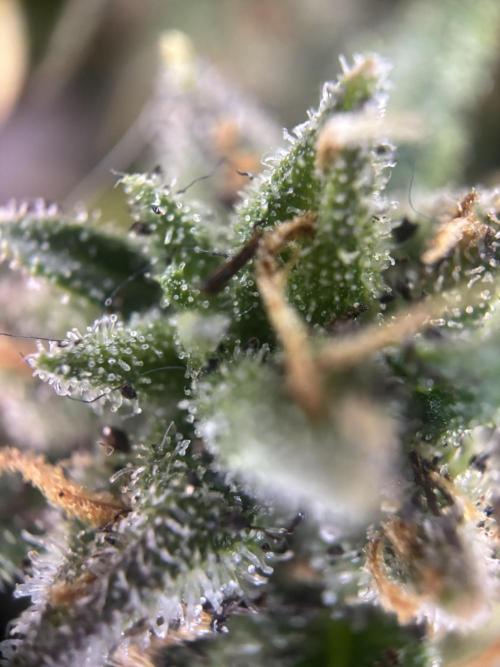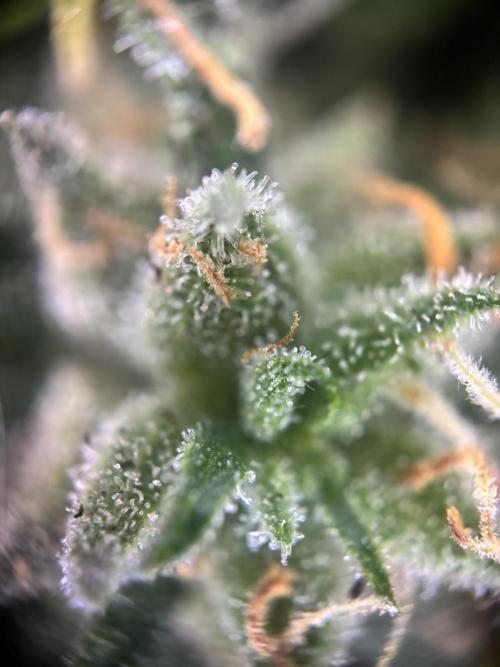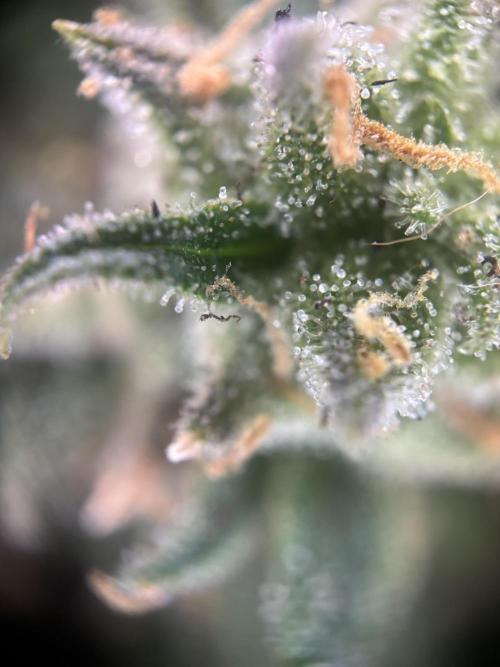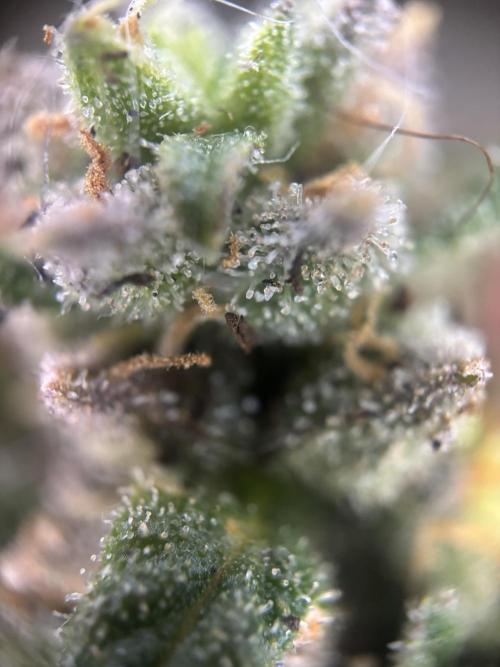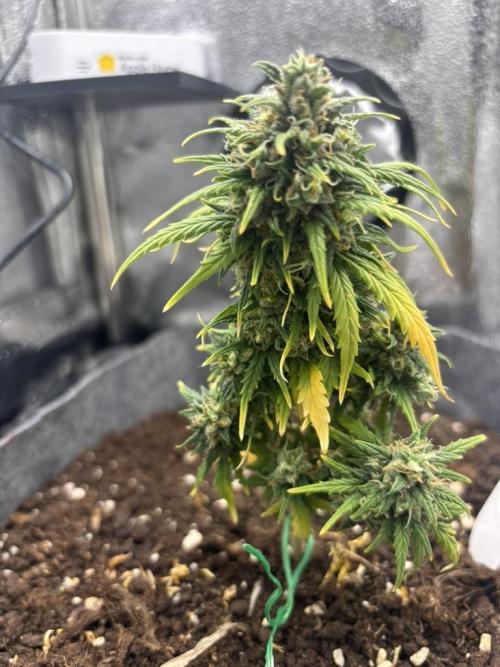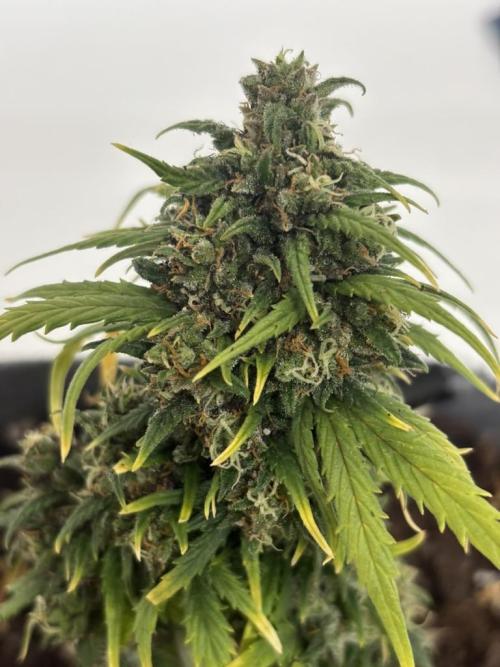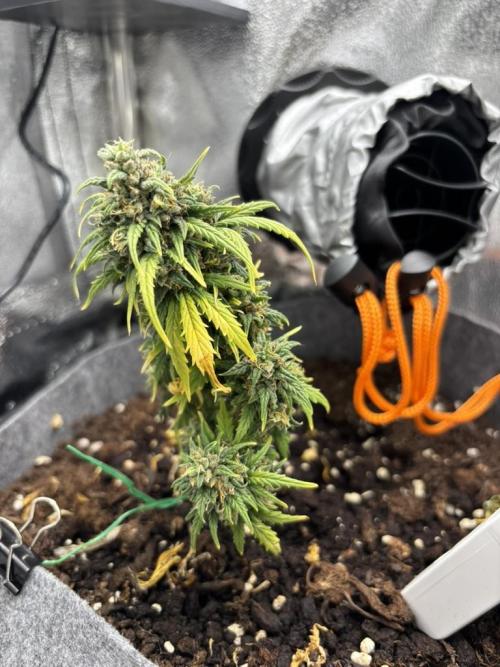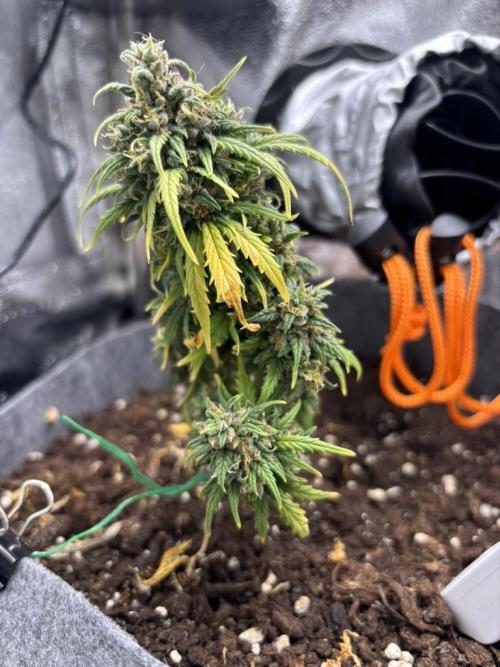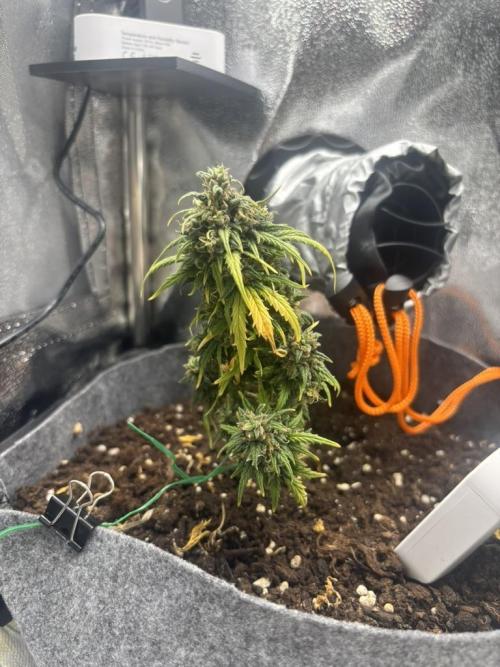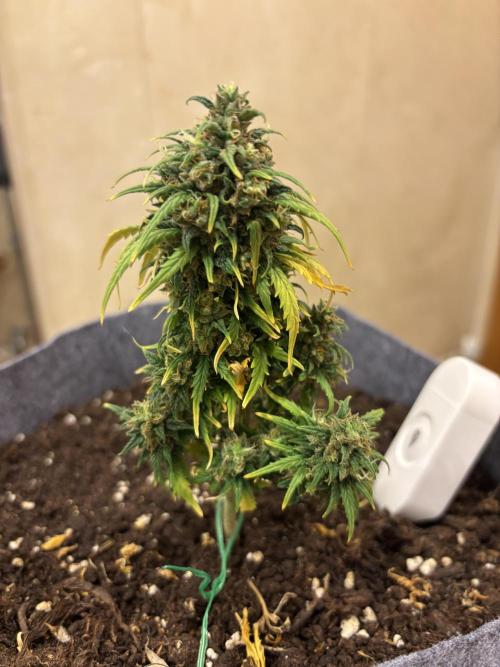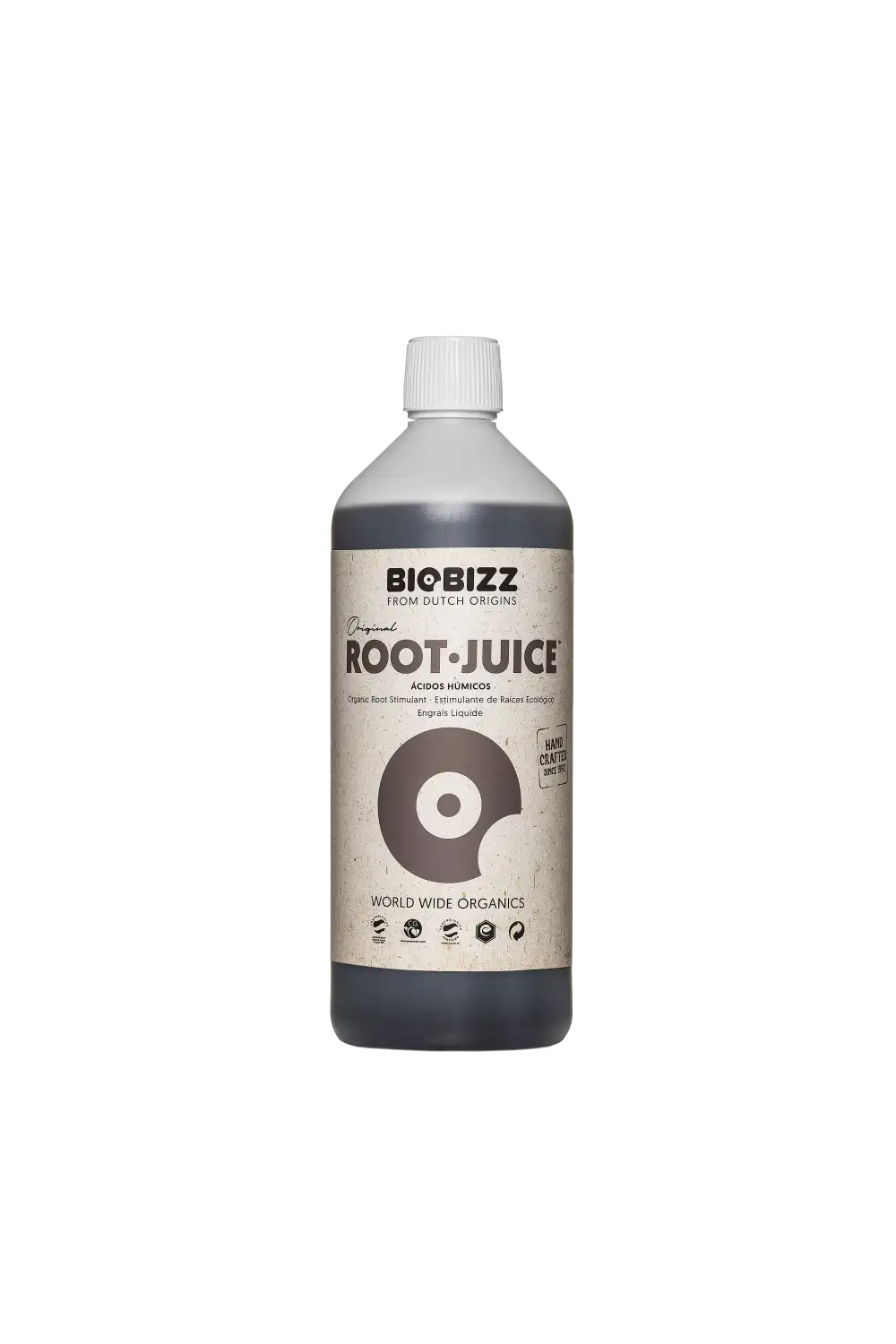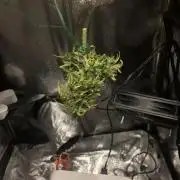The Grow Awards 2026 🏆 























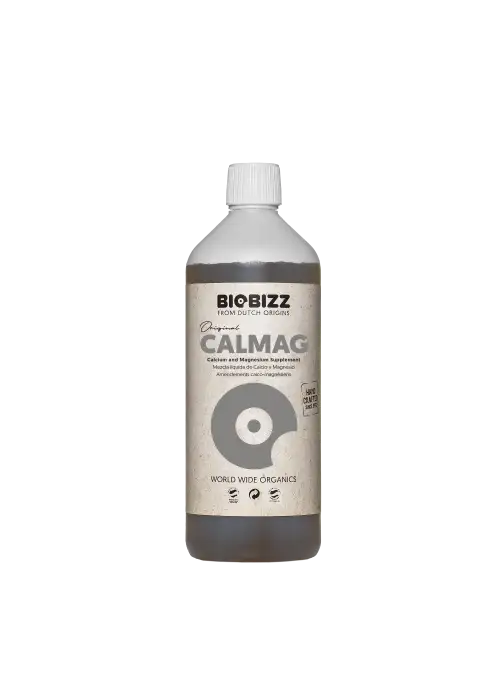





OpenGrowBox MicroGrowing

VEG
T1 Beast Light Emitting Diodes/65W
Farming Monkey

FLO
T1 Beast Light Emitting Diodes/65W
Farming Monkey

Tent
Mini (35x48x52cm)
DarkBox

Fan
Pure Fan Inline
Pure Factory

Fan
5V Pc Fan
noname

Contr
OpenGrow-Box
Home Assistant
Sustrato Universa Soil
Compo Sana
Indoor
Room Type
LST
weeks 3-5
Defoliation
weeks 4, 6-7, 10
5 liters
Pot Size
0.13 liters
Watering
Start at Harvest
G
Germination3mo ago
gamberro Welcome to my microgrowing project!
This is actually my second grow attempt. My first one was outdoors, but sadly the plant didn’t survive while I was away on vacation. This time, I’m taking things indoors with a completely different approach: ultra-limited space, maximum automation, and plenty of enthusiasm.
Setup:
- Grow space: 35x48x52 cm (yep, almost impossible – it’s originally a clone tent).
- Pot: 4-gallon fabric pot cut down to around 5 liters, bonsai-style. The idea is to keep the plant lower and avoid it getting too close to the light, since vertical space is super limited.
- Automation: everything is controlled via Home Assistant + OpenGrowBox project . Humidity, climate, and ventilation are all automated as much as possible.
Strain:
- Gorilla Z Auto (FastBuds) – a strong and popular autoflower. It was a gift from my grow.
Germination:
I started on Day 1 with the classic paper towel method. Within a couple of days, the seed cracked, showing a healthy white taproot.
On Day 3, 48 hours from the germination date, I prepared the soil by moistening it with 100 ml of water, then transplanted the seed into its final pot. To maintain high humidity, I used a cut plastic bottle as a mini greenhouse.
Progress:
- Day 1: seed placed in paper towel.
- Day 3: taproot emerging strong, transplanted into soil after moistening with 100 ml.
- Day 4: first sprout breaking through the surface.
Grower’s Notes:
- The space is ridiculously small, but it's the space that I have, which makes this a fun challenge.
- I’m very curious to see how FastBuds genetics will perform in such a restricted setup. It will need a lot of LST.
- This will basically be an experiment in extreme microgrowing, trying to make the most out of minimal resources.
2 likes
1 comment
Share
Used method
Paper Towel
Germination Method
1
Week 1. Vegetation3mo ago
6 cm
Height
16 hrs
Light Schedule
26 °C
Day Air Temp
6.6
pH
No Smell
Smell
65 %
Air Humidity
26 °C
Solution Temp
22 °C
Night Air Temp
5 liters
Pot Size
0.01 liters
Watering Volume
Nutrients 1

Acti-Vera
1 mll
gamberro This week marked the very beginning of the journey. On September 11th, the seedling received its very first watering: 50 ml with 0.1 ml of Acti·Vera by BioBizz, to encourage healthy root development and reduce early stress. A few days later, on Sunday the 14th, I repeated the same dose with another 50 ml.
Everything is being monitored through OpenGrowBox, and so far I’m really happy with the automation – it keeps the main parameters under control and makes things much easier. When it comes to watering, I still feel a bit uncertain: I’m giving small amounts because I don’t want to overdo it, but the substrate stays evenly moist, which tells me the plant is getting what it needs.
The pictures show the seedling evolving day by day: cotyledons opened strong, and within a couple of days the first set of true leaves appeared. The stem stretched a little, which is common in the early stage, but overall she looks healthy, with a nice green color and no signs of stress.
A promising start – the plant is settling well and ready to take off.
Day by Day – Week 1
Day 1 (Sep 11 – evening)
First watering after germination: 50 ml with 0.1 ml Acti·Vera (BioBizz). Cotyledons recently opened.
Day 2
The seedling is standing up straight, cotyledons are fully extended. Still small but looking healthy.
Day 3–4
The very first pair of true leaves starts to emerge. Stem elongates a bit as she reaches for the light.
Day 5 (Sep 14 – morning)
Second watering: 50 ml with 0.1 ml Acti·Vera (BioBizz). Leaves show a nice green color, no signs of stress.
Day 6
True leaves grow larger, stem looks a little stretched but strong. Substrate stays evenly moist.
Day 7
The seedling is settling nicely, developing the second set of true leaves. Healthy start to the journey!
2 likes
comments
Share
2
Week 2. Vegetation3mo ago
8 cm
Height
16 hrs
Light Schedule
25 °C
Day Air Temp
6.6
pH
No Smell
Smell
65 %
Air Humidity
25 °C
Solution Temp
20 °C
Night Air Temp
5 liters
Pot Size
0.01 liters
Watering Volume
Nutrients 2

Acti-Vera
1 mll

Root-Juice
2 mll
gamberro The seedling looks healthy this week, with a nice green color and good symmetry. The stem is still thin but standing strong, which is normal at this stage. The third set of true leaves is coming in and growth is progressing steadily.
The soil looks well-aerated with good drainage, no signs of overwatering. Environment seems stable thanks to the fan and climate control. Overall, she’s reacting well to the root stimulators and starting to build momentum for faster growth in the upcoming week.
Watering & Nutrients
- Day 8: 150ml of water with Acti-Vera (0.12ml) and Root-Juice (0.22ml).
- Day 10: 150ml with the same mix of Acti-Vera + Root-Juice.
- Day 14: 100ml of plain water.
3 likes
comments
Share
Grow Questions
gamberrostarted grow question 3mo ago
I’m wondering if this is the right moment to do a top cut (apical pruning). Should I wait a bit longer, or is it fine to do it now? Also, is it okay to top a FastBuds autoflower, or is it too risky? I’m dealing with some space limitations, only 52cm of vertical space. Thanks
Solved
Techniques. Topping
likes
3
Week 3. Vegetation3mo ago
9 cm
Height
16 hrs
Light Schedule
25 °C
Day Air Temp
6.6
pH
No Smell
Smell
65 %
Air Humidity
23 °C
Solution Temp
19 °C
Night Air Temp
5 liters
Pot Size
0.06 liters
Watering Volume
Nutrients 5

Acti-Vera
1 mll

Root-Juice
2 mll

Bio-Grow
2 mll
gamberro This week the girl kept developing nicely — she’s looking stronger and bushier every day. The leaves are a healthy green and she seems to be enjoying the environment so far.
On Sunday night I noticed the first signs of pre-flowering: a few little white hairs started showing, which means she’s already switching gears into the next stage. Exciting moment! You can see them clearly in the close-up shots.
On Monday I started some light LST (low stress training). The main reason is because of my limited grow space — she’s showing a very bushy structure, and I could already see that light wasn’t reaching the lower leaves properly. By bending her down I’m hoping to improve light penetration and open up the canopy. So far she has reacted well, no stress signs.
Watering has been consistent, around 200 ml each time, with nutrients added:
- Sep 25 (Day 17, Week 3): Acti-Vera (0.1 ml), Bio-Grow (0.2 ml), Root-Juice (0.4 ml) in 200 ml water.
- Sep 29 (Day 22, Week 4): Top-Max (0.2 ml), Bio-Grow (0.4 ml), Bio-Bloom (0.2 ml) in 200 ml water.
So far she’s reacting really well to the feeding schedule — no signs of burn or deficiencies.
Another thing that makes this grow so smooth is the OpenGrowBox project. Everything is super automated: it keeps perfect control of temperature, humidity and VPD, turning on and off the fans, extractors and humidifier exactly when needed. Honestly, I barely have to keep an eye on her — OpenGrowBox does the job really well and I’m really happy with how it works.
The structure is coming along nicely, and thanks to the LST I’m confident she will spread out with a better canopy for the upcoming weeks.
1 like
comments
Share
Used techniques
LST
Technique
Grow Questions
gamberrostarted grow question 3mo ago
First time trying LST. I have very limited space and my plant is getting bushy, so I used garden wire + clips to bend her down (see pics). Not sure if I did it right. Any tips or corrections are welcome!
Solved
Techniques. LST
likes
00110001001001111Oanswered grow question 3mo ago
You want an anchor at base of plant tied to opposite side -- this prevents the plant from pulling/damaging its roots. It may look fine today, but resistance over time can pull it through the substrate.
Training is simply about manipulating apical dominance. Tallest growth tip on more primary branch will take the most resources and grow the fastest. LST is attempting to spread that strongest growth out across more than 1 branch. The more level you make it, the more even the growth distribution will be...
Growth may not be perfectly even, initially, but you can further manipulate it by temporary tying the taller branches lower than the shorter ones and it will even out quickly. Release when even.
to get a more horizontal bend, try bending in 2-3 spots close together... don't need to damage vascular tissue, so don't do this to the point of feeling it get squishy or anything like that... just creating multiple points in stem that help it create a near-90-degree bend. Now is the time to tie it down with the anchor in place and the bend if mostly formed on its own. The tie-down can pull it down the last little bit to level it out.
you usually get too many branches with LST. So, i'd bend it 'on a growth axis' so 1 is pointing up and symmetrical growth is pointing down.. .prune off branches facing down. You can always bend down between growth axes and now you have 2 branches at a 45-degree angle that can both easily grow upward, but like i said, usually don't nee dso many branches emenating from a small stretch of trunk.
Also, have a plan. you want 2.5-3 colas per sq ft... divide that by number of plants.. and you know how many colas you want per plant... don't waste time overcrowding beyond that. once you have the right number of vertical or future vertical branches, even it out and let it go. Easy to apply to any size area and any number of plants... just be systematic and it'll save you time, money and effort. Cutting off a bunch of growth is just wasting your money and time. find a path that reaches end goal of canopy with least amount of waste.
4
Week 4. Flowering3mo ago
10 cm
Height
16 hrs
Light Schedule
26 °C
Day Air Temp
6.5
pH
Weak
Smell
55 %
Air Humidity
23 °C
Solution Temp
19 °C
Night Air Temp
5 liters
Pot Size
0.1 liters
Watering Volume
20 cm
Lamp Distance
Nutrients 3

Acti-Vera
1 mll

Bio-Grow
2 mll

Bio-Bloom
1 mll
gamberro This week I got a really helpful comment from another grower — he mentioned that my plant looked too small for her age and suggested I check the light distance. As a complete newbie, I realized I hadn’t adjusted the light height at all during the whole grow. It was way too high from the start. Once I lowered it (since my light isn’t super powerful anyway), the difference was instant! The plant started showing much better growth, the leaves look healthier and perkier, and overall she’s looking way happier.
Small Defoliation & LST Update
I also did a small defoliation, removing a few big fan leaves that were blocking light to the lower branches. Now the lower sites are getting much more light, and the LST is helping the plant open up beautifully — lots of healthy new growth points are forming .
Watering & Nutrients
Two watering sessions this week with BioBizz nutrients:
- Sep 30: 500 ml total
- Acti-Vera: 0.5 ml
- Bio-Bloom: 0.5 ml
- Bio-Grow: 1 ml
- Oct 4: 200 ml small maintenance watering
- Acti-Vera: 0.2 ml
- Bio-Bloom: 0.2 ml
- Bio-Grow: 0.4 ml
Everything was well received — no signs of overwatering or nutrient stress.
General Notes:
- Adjusted light height → huge improvement
- Slight defoliation to expose lower branches
- Continued LST training
- Two feedings with BioBizz nutrients
- Healthy color and structure
- Bud sites developing nicely
She’s looking much happier now! Excited to see how she keeps responding in the coming days.
4 likes
comments
Share
Used techniques
LST
Technique
Defoliation
Technique
Grow Questions
5
Week 5. Flowering2mo ago
12 cm
Height
16 hrs
Light Schedule
26 °C
Day Air Temp
6.5
pH
Weak
Smell
55 %
Air Humidity
23 °C
Solution Temp
20 °C
Night Air Temp
5 liters
Pot Size
0.1 liters
Watering Volume
20 cm
Lamp Distance
Nutrients 4

Acti-Vera
1 mll

Bio-Grow
1 mll

Bio-Bloom
2 mll
gamberro Learning the hard way – Overfeeding and recovery mode
This week started off looking good, but things took a turn after my mid-week feeding. On October 8th, I gave her a mix of Bio-Grow (0.5 ml), Bio-Bloom (1 ml) and Top-Max (1 ml) per 500 ml of water, thinking she could handle it — but that’s when the problems began.
A few days later, I noticed the lower leaves turning yellow and the overall color getting darker — clear signs of overfeeding / nutrient burn. Once again, thanks to the awesome GrowDiaries community, I realized I’d gone too far with the nutrients. Classic rookie mistake!
To correct it, on October 12th I watered only with plain water + Acti-Vera (0.2 ml x 200 ml) to help flush and let her recover. For the rest of the week, I’ll continue watering lightly with the same mix, to give the roots time to breathe and clean themselves out.
Despite the stress, she’s still doing okay — buds are forming nicely, and new growth looks healthy and green. The yellowing on the lower leaves is still visible, but she’s pushing through.
No pruning or major training this week, just maintaining the LST to keep her open and get even light exposure.
Lesson learned: less is more when it comes to feeding!
Waterings / Feedings
- Oct 8: Bio-Grow 0.5 ml/L, Bio-Bloom 1 ml/L, Top-Max 1 ml/L – 500 ml total
- Oct 12: Acti-Vera 0.2 ml/L – 200 ml total (light watering for recovery)
3 likes
comments
Share
Used techniques
LST
Technique
6
Week 6. Flowering2mo ago
12 cm
Height
16 hrs
Light Schedule
24 °C
Day Air Temp
6.5
pH
Weak
Smell
55 %
Air Humidity
23 °C
Solution Temp
19 °C
Night Air Temp
5 liters
Pot Size
0.06 liters
Watering Volume
20 cm
Lamp Distance
Nutrients 2

Acti-Vera
1 mll

Alg-A-Mic
0.264 mll
gamberro This week was all about recovery. After last week’s mistakes, I’ve accepted that this run will stay small—but for a first grow I’m fine with that. The new goal is simple: stabilize her and see if we can still fatten the buds.
Lower leaves kept yellowing while older fan tips showed a bit of burn—classic after-effects of overfeeding. The good news: new growth looks green, pistils are fresh, and the little tops are stacking. I kept the LST in place to open the center and avoided any extra stress (no pruning, just removing a couple of fully yellow leaves).
Feeding-wise I parked the heavy stuff. I switched to light, tonic-style watering only: tiny volumes and gentle additives to help the roots breathe and recover. Environment stayed steady with good airflow and no overwatering.
Lesson re-learned: less is more with nutrients—especially on a small auto.
Waterings / Feedings
- Oct 16: 200 ml water + Acti-Vera 0.2 ml + Alg-A-Mic 0.2 ml (light, anti-stress mix)
- Oct 19: 200 ml water + Acti-Vera 0.2 ml + Alg-A-Mic 0.2 ml (continued recovery)
Next steps: keep the gentle schedule, watch pot weight, and if she keeps greening up, consider a very mild bloom feed later—only after clear signs of recovery.
2 likes
comments
Share
Used techniques
Defoliation
Technique
Grow Questions
gamberrostarted grow question 2mo ago
My small plant (about 15cm) suddenly got droopy overnight. It’s in a 5L pot, last watering was 4 days ago (200ml). Humidity around 55%, LED 65W giving 61k lux. Top soil feels dry but still moist at the bottom (22% on meter). Did I overwater it or is something else wrong?
Solved
Leaves. Curl down
likes
Green_clawsanswered grow question 2mo ago
Just had a quick look threw your diary. Your doing OK for your 1st grow and glad to see your carrying on till harvest learning along the way 👍.
The plant hasn't rooted into that massive pot so please don't water the entire pot you will on create problem with it taking to long to dry back root rot etc.. So just do rings around the base of the plants, it's not ideal but you have to work with what you have got.. Keep on the Calmag and bloom feed just keep it at a small amount because there's not much of a plant so feed in propertion to that.. Good luck
7
Week 7. Flowering2mo ago
12 cm
Height
16 hrs
Light Schedule
23 °C
Day Air Temp
6.5
pH
Weak
Smell
55 %
Air Humidity
23 °C
Solution Temp
18 °C
Night Air Temp
5 liters
Pot Size
0.09 liters
Watering Volume
20 cm
Lamp Distance
Nutrients 5

Acti-Vera
2.5 mll

Alg-A-Mic
0.264 mll

Calmag
0.528 mll
gamberro Buds keep stacking—more fresh white pistils than last week and a bit more frosting on the tops. Overall growth is still slow and the plant remains very compact. Lower fan leaves continue yellowing (older stress showing) and you can see some condensation on the tent walls, so I boosted airflow to keep RH in check.
I stopped the LST this week—the root system feels weak and I don’t want to risk snapping branches or stressing her more. Only removed a couple of leaves that were fully dry and came off on their own.
Watering & nutrients
- Oct 23: 200 ml — Alg-A-Mic 0.1 ml, Bio-Bloom 0.2 ml, Top-Max 0.1 ml, Bio-Grow 0.1 ml.
- Oct 25: 200 ml — Alg-A-Mic 0.1 ml, Cal-Mag 0.1 ml.
- Oct 28: 200 ml — Acti·Vera 0.5 ml, Bio-Bloom 0.4 ml, Top-Max 0.4 ml, Cal-Mag 0.4 ml.
Keeping small, frequent waterings (200 ml) so the medium breathes and roots aren’t overworked. No new burn at these doses; new growth looks stable.
Timing / expectations
We’re getting close to the 9 weeks advertised by the breeder, but it’s almost impossible she’ll be ready then. The accumulated stress clearly set her back, and she stayed very small. I’m planning for extra weeks beyond the label to let her mature properly.
Plan for next week
Hold the course: gentle feed, tight humidity control, no more training, and only minimal leaf removal if a leaf is fully spent. Patience over speed—let her catch up.
2 likes
comments
Share
Used techniques
Defoliation
Technique
8
Week 8. Flowering2mo ago
12 cm
Height
16 hrs
Light Schedule
22 °C
Day Air Temp
6.5
pH
Weak
Smell
40 %
Air Humidity
23 °C
Solution Temp
18 °C
Night Air Temp
5 liters
Pot Size
0.11 liters
Watering Volume
20 cm
Lamp Distance
Nutrients 5

Alg-A-Mic
0.264 mll

Calmag
0.132 mll

Bio-Bloom
0.396 mll
gamberro Still tiny but hanging in there. Buds have put on a bit of weight, lots of white pistils left, so even if the breeder says she should be ready next week, I don’t see her there yet. Lower leaves are fading as expected this late, a couple of light burnt tips, and humidity has been high at times (working on airflow). It’s a small plant, but a good learning run for dialing in watering/feeding. I’ll start the flush next week.
Watering & feeding
- Oct 31 – Plain water, 200 ml.
- Nov 2 – Nutrients, 600 ml total: Alg-A-Mic 0.6 ml, Bio-Bloom 0.9 ml, Bio-Grow 0.3 ml, Cal-Mag 0.3 ml, Top-Max 0.6 ml.
Notes / plan for next week
- Begin root flush (water only, adjust by pot weight).
- Keep RH down and airflow up to avoid late-flower issues.
- Watch trichomes for mostly cloudy and the first ambers before thinking about chop.
6 likes
comments
Share
9
Week 9. Flowering1mo ago
12 cm
Height
16 hrs
Light Schedule
21 °C
Day Air Temp
6.5
pH
Strong
Smell
40 %
Air Humidity
22 °C
Solution Temp
17 °C
Night Air Temp
5 liters
Pot Size
0.11 liters
Watering Volume
20 cm
Lamp Distance
gamberro This week has been all about maturation. I’ve been watering only with plain water, starting the flush to clean the roots before harvest. The buds are looking dense and compact, covered in a nice layer of trichomes that keep getting frostier day by day.
The lower leaves are yellowing, which is normal at this stage since the plant is using up the remaining nutrients stored in the foliage. Trichomes are mostly clear with some turning milky, so I think she will be ready for harvest in about a week.
Overall, the plant looks healthy and stable, with tight bud formation and a great aroma coming out. Even though she stayed quite small, she’s packing some nice, solid flowers.
Watering: only water (about 600 ml)Environment: stable and controlled
Stage: late flowering / flushing phase
Next: monitor trichomes daily and prepare for harvest
7 likes
comments
Share
Grow Questions
gamberrostarted grow question 1mo ago
Checking trichomes and they look mostly milky with some still clear. I prefer a more uplifting, cerebral effect rather than a heavy one. Based on the pics, how much longer do you think she might need before harvest? Curious to hear your thoughts!
Solved
Buds. Other
1 like
10
Week 10. Flowering1mo ago
12 cm
Height
16 hrs
Light Schedule
21 °C
Day Air Temp
6.5
pH
Strong
Smell
40 %
Air Humidity
22 °C
Solution Temp
17 °C
Night Air Temp
5 liters
Pot Size
0.13 liters
Watering Volume
20 cm
Lamp Distance
gamberro Still in flush mode this week. I’ve been watering with plain water for a couple of weeks now, partly because the breeder’s estimate said she should already be done, and partly because this is my first grow and I’m definitely impatient 😅. I also really don’t want her to go too far into the heavy, narcotic side – I’m aiming for a more uplifting, cerebral effect, so I’d rather harvest a bit early than too late.
The plant itself is clearly in late flower now: most fan leaves are yellow or already gone, while the buds stay compact and frosty. The daily photos show that she isn’t growing much taller anymore, but the flowers keep tightening up and the pistils are turning from white to orange, especially on the top cola. For such a tiny plant, the main bud actually looks quite chunky and well formed.
The new macro pictures of the trichomes were really helpful: most heads are now milky, with still a few clear ones and just the very first ambers starting to appear here and there. That puts her right at the beginning of the ideal window for the type of effect I’m after. My feeling is that harvest time is very close now – probably within days – so I’ll keep checking trichomes daily and decide the chop based on how fast those clear ones disappear.
Watering (flush continues)
Nov 12 – 600 ml plain water
Nov 17 – 320 ml plain water
Notes / plan for next week
Keep giving only water, adjusting volume by pot weight.
Watch trichomes closely: aiming for mostly cloudy with just a small touch of amber.
Likely harvest window in the coming days, before she gets too sleepy/heavy.
4 likes
comments
Share
Used techniques
Defoliation
Technique
Grow Questions
gamberrostarted grow question 1mo ago
Are my trichomes ready yet? I’m aiming for a more uplifting, cerebral effect, but most trichomes still look clear. Should I wait a bit longer before harvesting? Any advice is appreciated!
Solved
Buds. Other
1 like
GrowerOGanswered grow question 1mo ago
Hello mate, looking your photos and the description of the strain, you would harvest now if you want more uplifting and cerebral effect. The trichomes in the photos are enough cloudy i think and some already amber so if you wait much longer you could have too many trichomes amber so more body effect.
Good luck and happy harvest!
11
Week 11. Flowering1mo ago
12 cm
Height
16 hrs
Light Schedule
20 °C
Day Air Temp
6.5
pH
Strong
Smell
40 %
Air Humidity
22 °C
Solution Temp
17 °C
Night Air Temp
5 liters
Pot Size
0.13 liters
Watering Volume
20 cm
Lamp Distance
gamberro This was the final week for this little Gorilla Z, and you can really see it in the photos. Almost all of the fan leaves have completely faded to yellow, some crisping up and hanging down, while the buds themselves stayed compact, green and nicely frosty. The top cola looks like a proper little bonsai spear now, with most pistils turned orange and only a few fresh white ones left here and there. Some sugar leaves show yellow tips and a bit of clawing, clear signs that she’s at the end of her energy, but the flowers still look healthy and dense.
On the 20th I gave her one last watering, about 600 ml of plain water, just to finish the flush and let her use up whatever was left inside. After that, no more water. On Sunday I turned the light off and left her in darkness to finish ripening. Today I finally chopped her down, at Day 79 from sprout. She is absolutely tiny and the yield will only be a few grams, but for a first indoor attempt in this micro setup, my main goal was to bring her all the way to harvest and finish the cycle properly. Mission accomplished, and a lot of lessons learned for the next run.
Watering / flush
Nov 20 – 600 ml plain water (last watering of the grow)
Stage / notes
End of flush, full fade on fan leaves
Trichomes mostly cloudy with some ambers, pistils mostly orange
Lights off on Sunday, harvest today at Day 79 from seed
Very small plant, but nice, resinous buds and a completed first grow
2 likes
comments
Share
12
Week 12. Harvest1mo ago
Happy Harvest Day!

8/10
Rated
First indoor grow and first time with Fast Buds. I ran this Gorilla Z Auto in a very small micro box (35x48x52 cm) with a 5 L pot and made plenty of rookie mistakes: light too high at the start, overfeeding and a big pot that the plant never fully rooted into. Even with all that, she never hermed, handled the stress, and still finished around day 79 from sprout with dense, frosty buds and a strong smell. The plant stayed tiny because of my setup and errors, not the genetics. I think in a normal tent and with better watering/feeding she could easily show her full potential.
Show more
Translate
Spent 79 days
Ger Veg Flo Har
1
Plants
0.16 m²
Grow Room size
Normal
Difficulty
Height
Day air temperature
Air humidity
PH
Light schedule
Solution temperature
Night air temperature
Pot size
Lamp distance
gamberro —
2 likes
comments
Share
Equipment Reviews

the end.
Enjoying this diary? Follow for more updates!
Prefer the old Diary view?
Go back to the old Diary view




